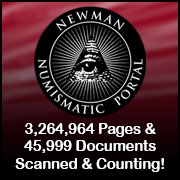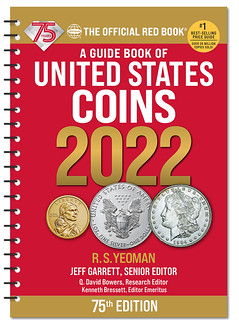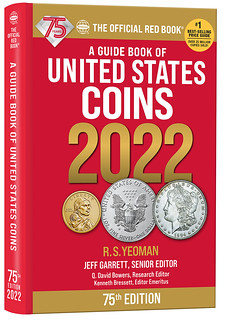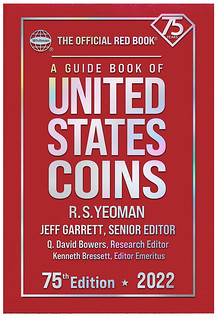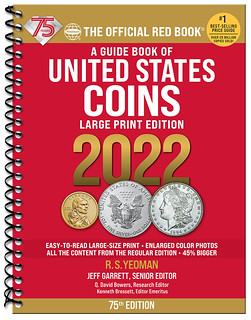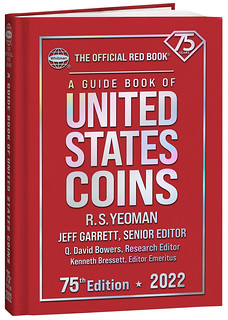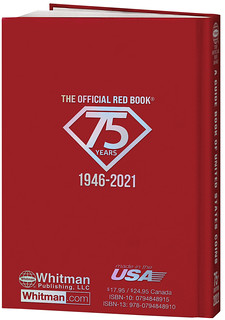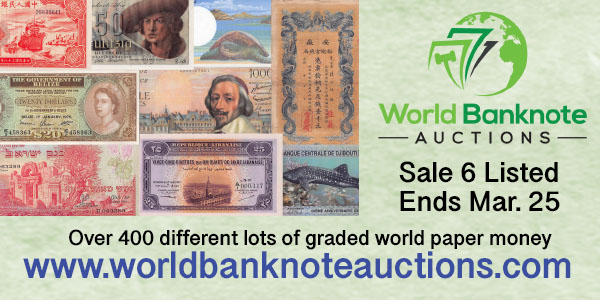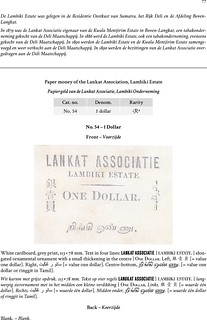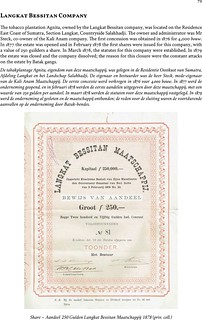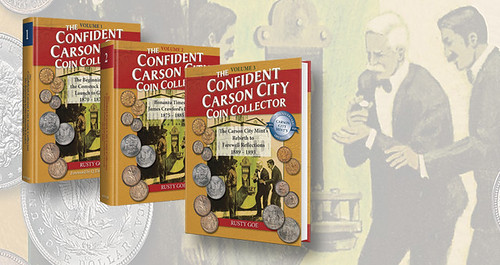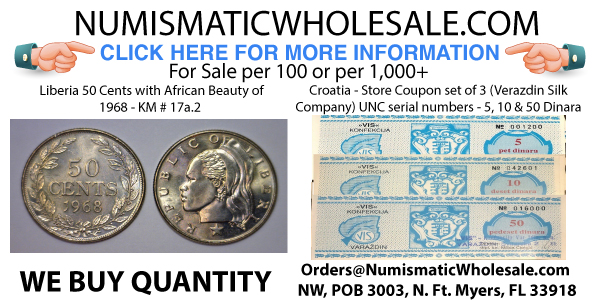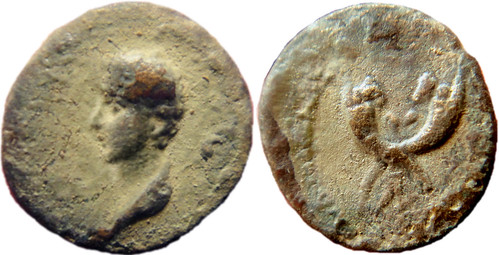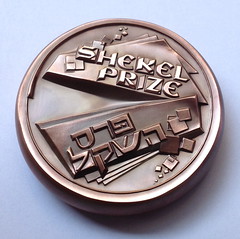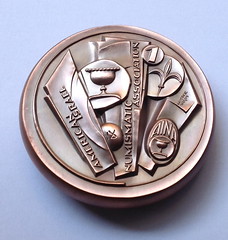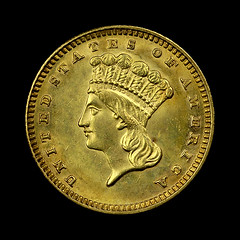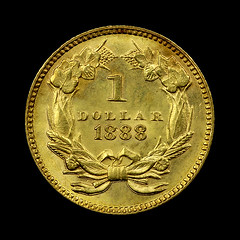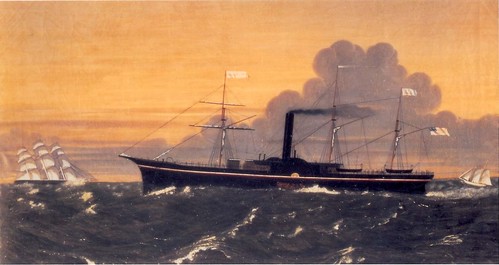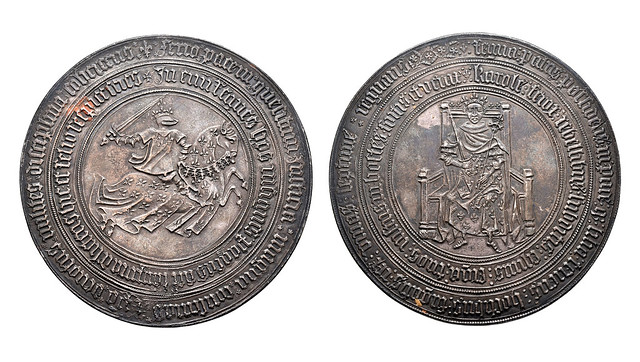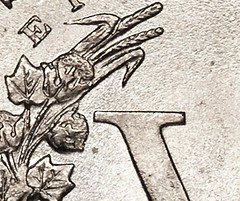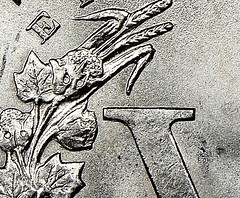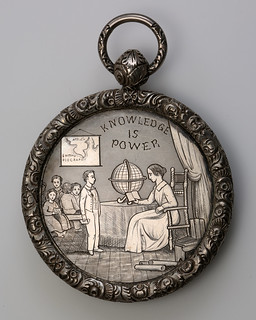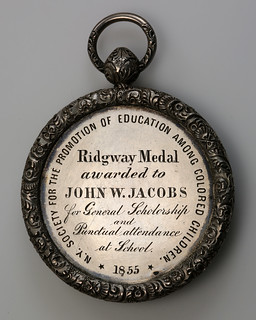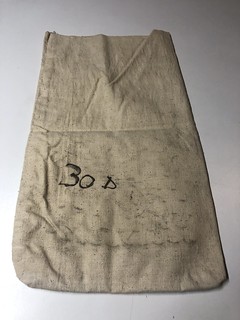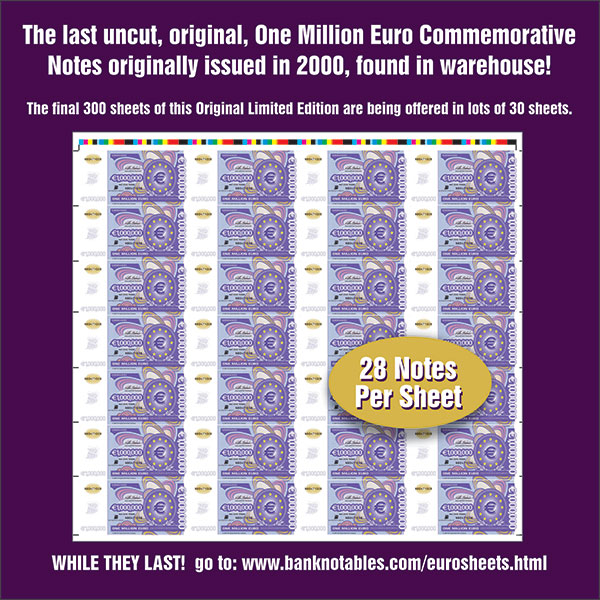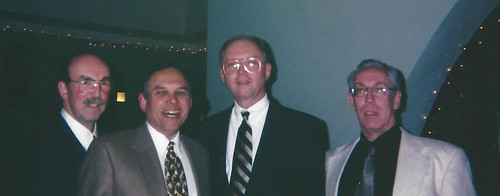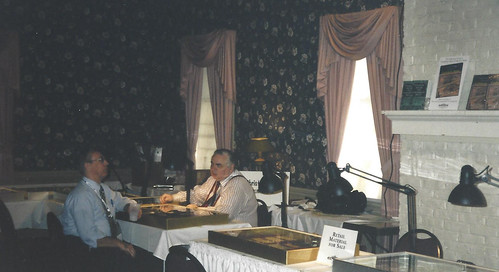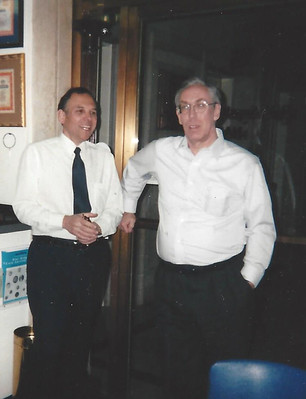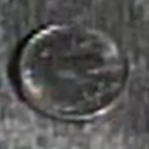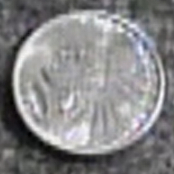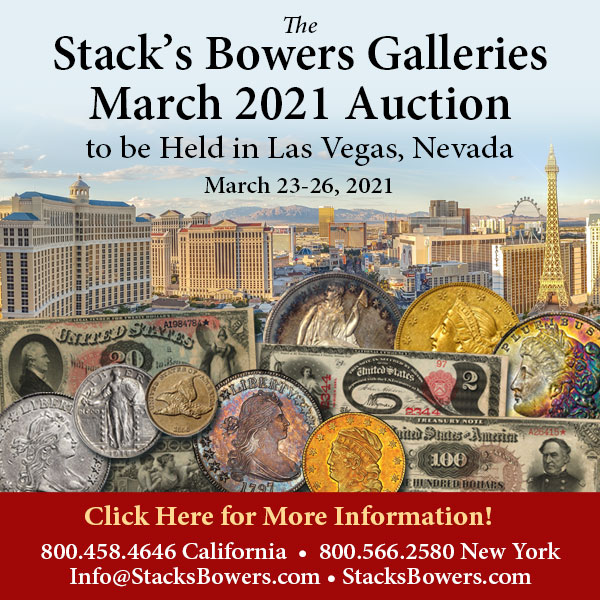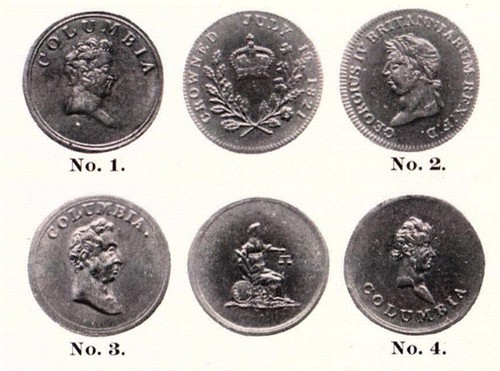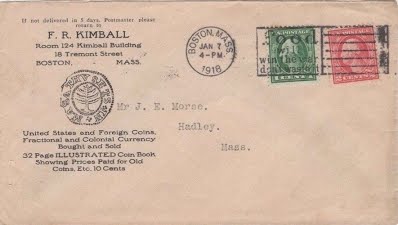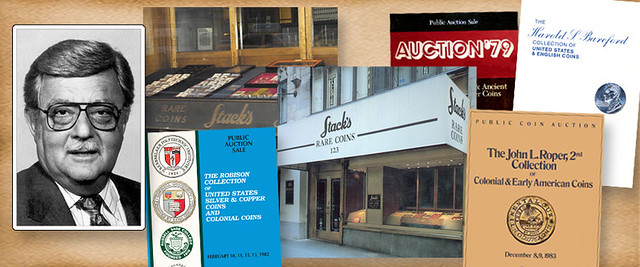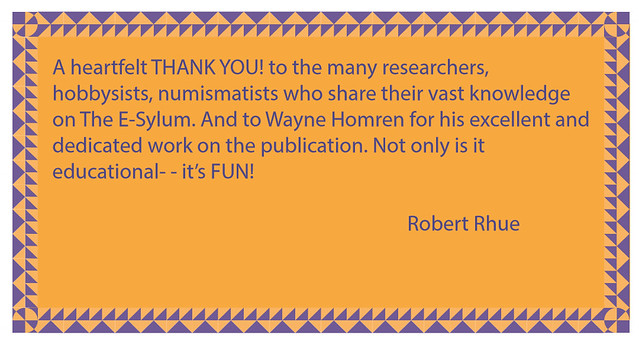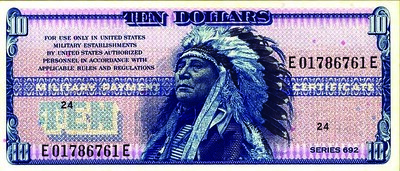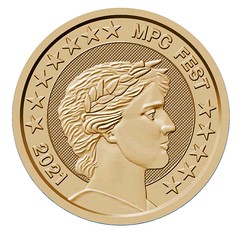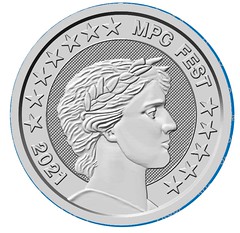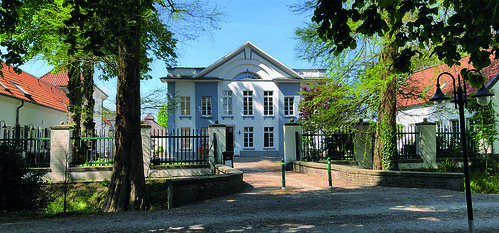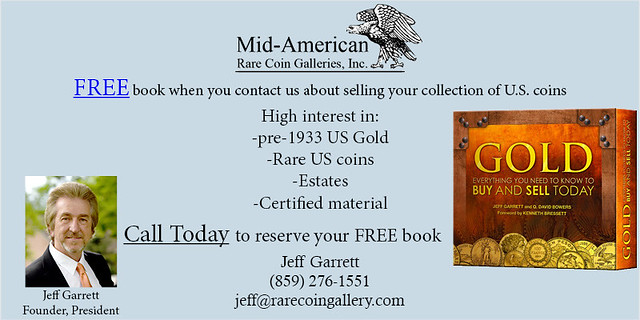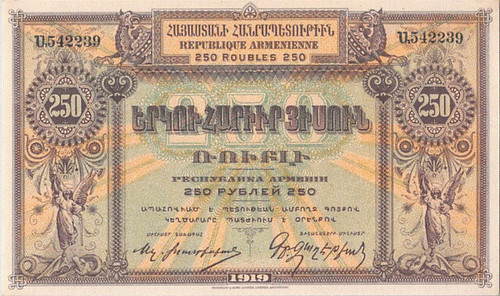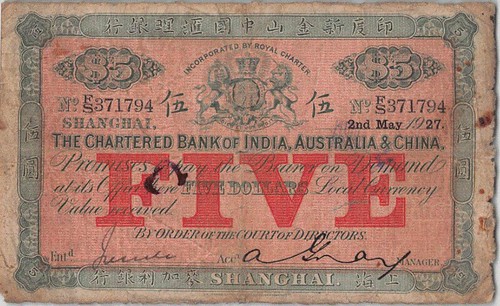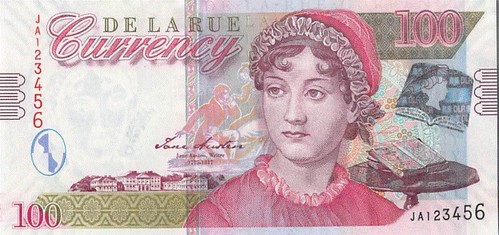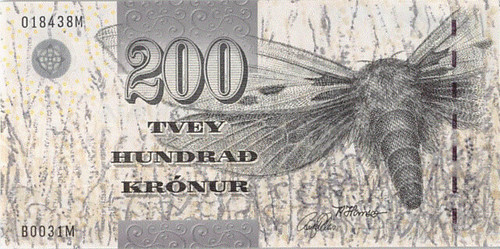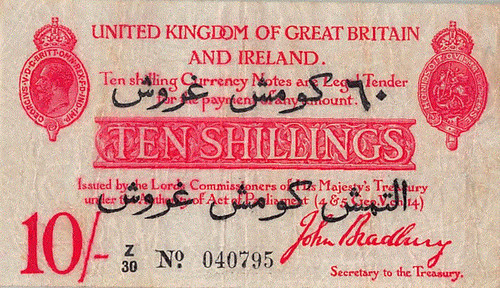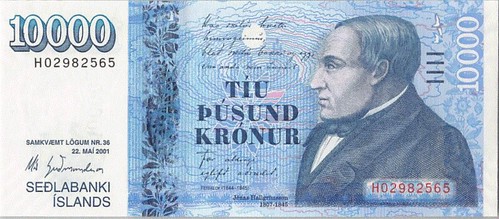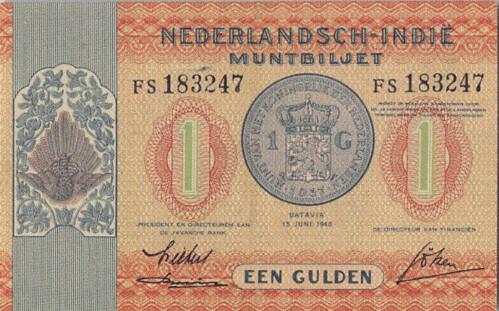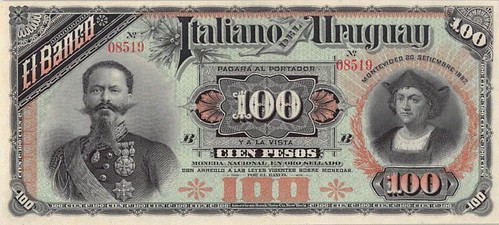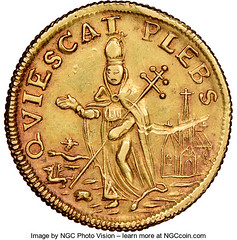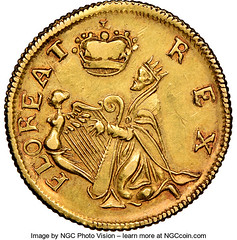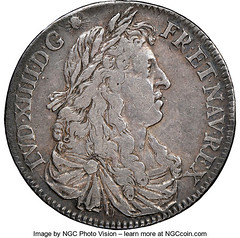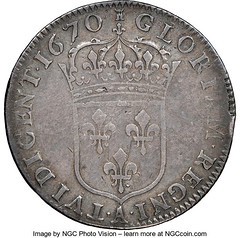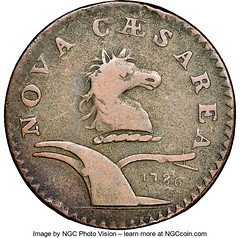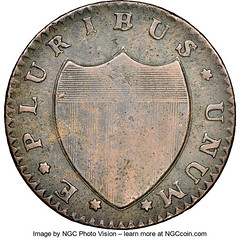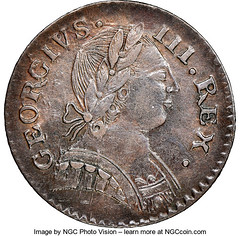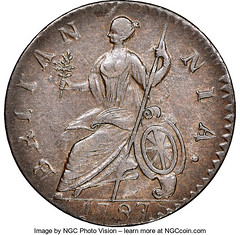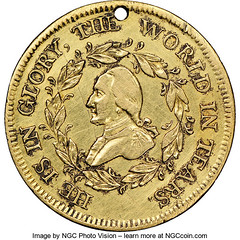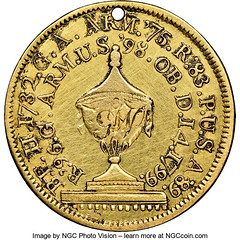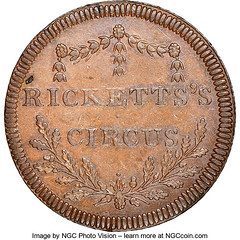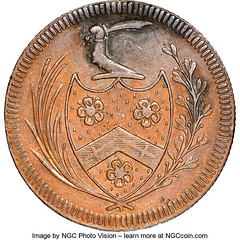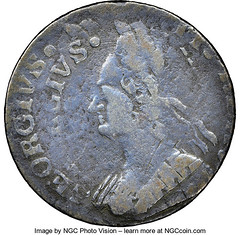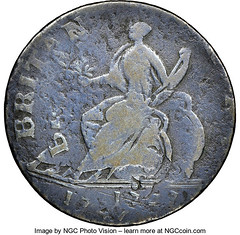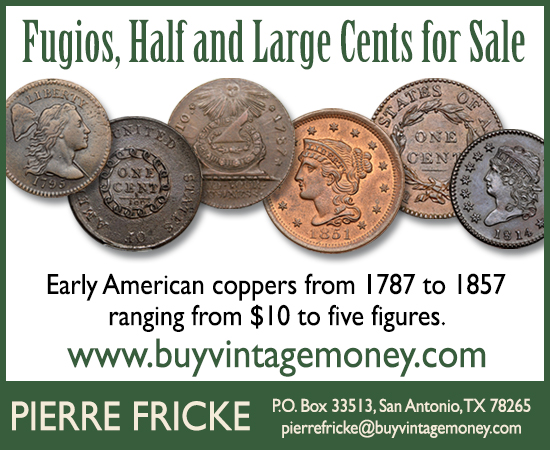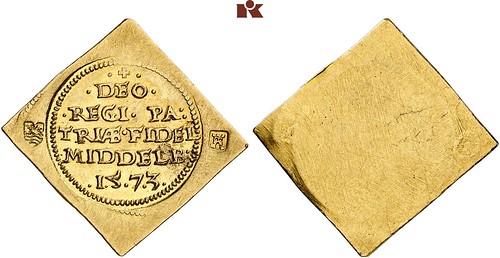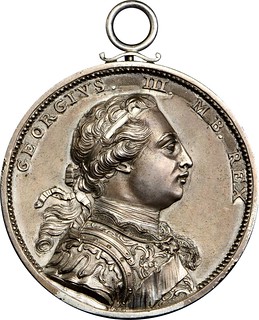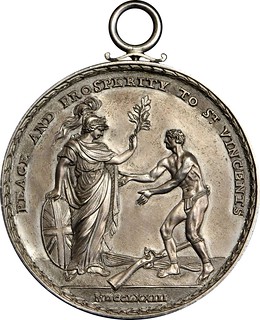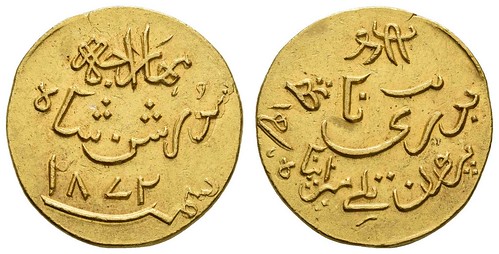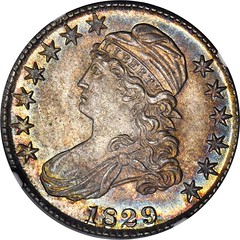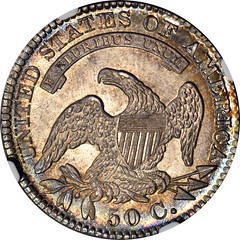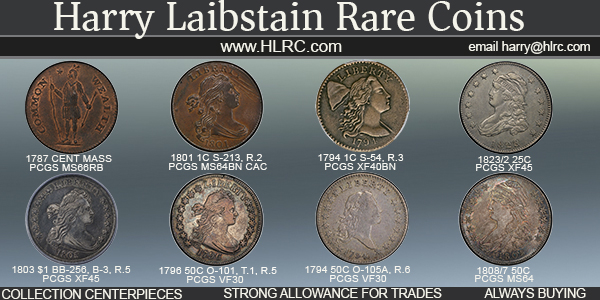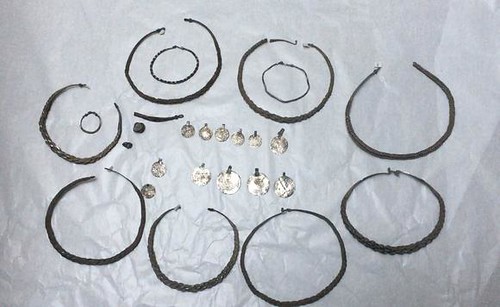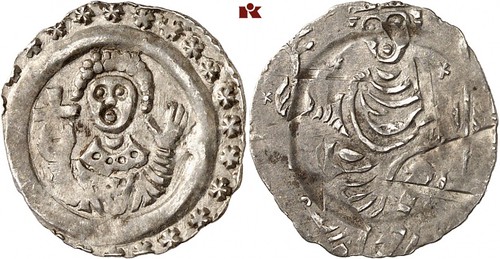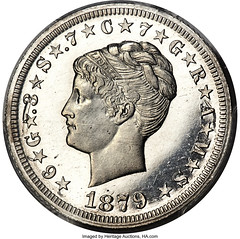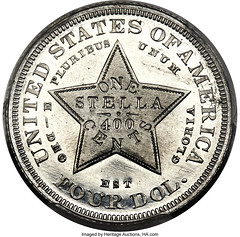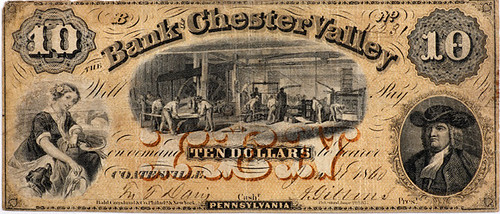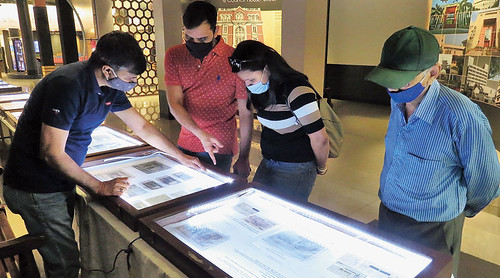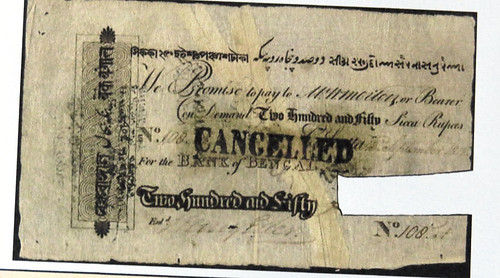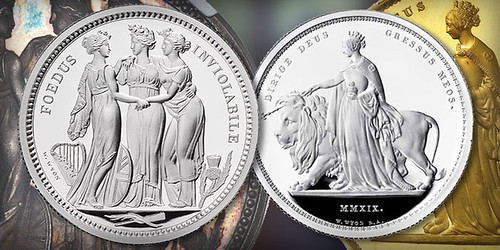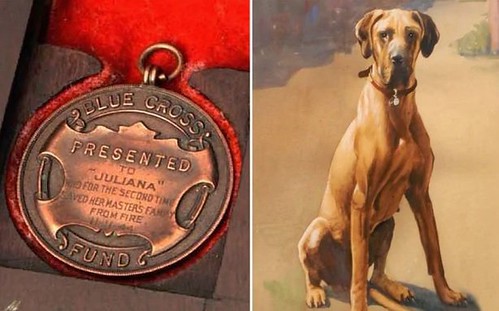
Visit our NBS Sponsors


About UsThe Numismatic Bibliomania Society is a non-profit association devoted to the study and enjoyment of numismatic literature. For more information please see our web site at coinbooks.org SubscriptionsThose wishing to become new E-Sylum subscribers (or wishing to Unsubscribe) can go to the following web page link MembershipThere is a membership application available on the web site Membership Application To join, print the application and return it with your check to the address printed on the application. Print/Digital membership is $40 to addresses in the U.S., and $60 elsewhere. A digital-only membership is available for $25. For those without web access, write to: Charles Heck, Treasurer AsylumFor Asylum mailing address changes and other membership questions, contact Chuck at this email address: treasurer@coinbooks.org SubmissionsTo submit items for publication in The E-Sylum, write to the Editor at this address: whomren@gmail.com BUY THE BOOK BEFORE THE COINSale Calendar
|
- WAYNE'S WORDS: THE E-SYLUM MARCH 14, 2021
- NEW BOOK: GUIDE BOOK OF U.S. COINS, 75TH ED.
- NEW BOOK: AUSTRALIAN PRE-DECIMAL VARIETIES
- NEW BOOK: PAPER MONEY OF ESTATES OF SUMATRA
- NEW BOOK: PRISONER-OF-WAR CAMP MONEY
- BOOK REVIEW: CONFIDENT CARSON CITY COLLECTOR
- DAVID JACOBSON WINS 2021 SHEKEL PRIZE
- COINAGE OF 1888 DESIGNED TO AVOID SPECULATION
- SYMPOSIUM: SS CENTRAL AMERICA DISCOVERIES
- VIDEO: MARCH 2021 COLLECTORAMA SHOW
- CHALLENGER WHISTLEBLOWER COMMEMORATIVE?
- NOTES FROM E-SYLUM READERS: MARCH 14, 2021
- MORE FROM E-SYLUM READERS: MARCH 14, 2021
- HARVEY STACK ON THE HOLLAND SALE
- QUERY: COLUMBIA FARTHINGS
- BOOKHUNTING IN VIET NAM
- VOCABULARY TERM: CURATING
- FRANCIS RICHARD KIMBALL (1859-1922)
- HARVEY STACK'S NUMISMATIC FAMILY, PART 91
- MEDALLIC ARTIST HEIDI WASTWEET
- BEP ARTIST LEN BUCKLEY TO SPEAK AT MPCFEST
- FAROUK 1933 DOUBLE EAGLE RETURNS TO MARKET
- MUENZEN GUT-LYNT ONLINE AUCTIONS
- WORLD BANKNOTE AUCTIONS SALE 6 SELECTIONS
- HERITAGE MARCH 2021 PARTRICK SALE SELECTIONS
- NUMISMATIC NUGGETS: MARCH 14, 2021
- THE VIGGBYHOLM HOARD OF VIKING SILVER
- THE MARKSTETTEN COIN HOARD
- 1879 $4 COILED HAIR STELLA IN ALUMINUM
- REBECCA LUKENS’S IRON MILL
- INDIAN BANKNOTE EXHIBIT
- BITCOIN BANKNOTES
- LOOSE CHANGE: MARCH 14, 2021
Click here to read the thin version on the web
Click here to subscribe
Click here to access the complete archive
To comment or submit articles, reply to whomren@gmail.com
Content presented in The E-Sylum is not necessarily researched or independently fact-checked, and views expressed do not necessarily represent those of the Numismatic Bibliomania Society.
WAYNE'S WORDS: THE E-SYLUM MARCH 14, 2021
 New subscribers this week include: Nisipeanu Ionut Silvian, and Ernie West. Welcome aboard! We now have 6,614 subscribers.
New subscribers this week include: Nisipeanu Ionut Silvian, and Ernie West. Welcome aboard! We now have 6,614 subscribers.
Thank you for reading The E-Sylum. If you enjoy it, please send me the email addresses of friends you think may enjoy it as well and I'll send them a subscription. Contact me at whomren@gmail.com anytime regarding your subscription, or questions, comments or suggestions about our content.
This week we open with four new books, a book review, the Shekel prize winner, updates from the Newman Numismatic Portal, and more.
Other topics this week include the U.S. coinage of 1888, the S.S. Central America, notes from E-Sylum readers, the Pennypacker Holland sale, Columbia Farthings, Heidi Wastweet, the Farouk 1933 Double Eagle, auction selections, medieval coin hoards, the 1879 aluminum Stella, Rebecca Lukens's iron mill, and Indian banknotes.
To learn more about Carson City coinage, the last Herodian monarch Agrippa II, U.S. Mint Director James Kimball, Boston dealer F. R. Kimball, John L. Roper II, the Ridgway medal, the 1921-S Zerbe dollars, Poker and Numismatics, De La Rue Test Notes, Ricketts's Circus token, and Bitcoin banknotes, read on. Have a great week, everyone!
Wayne Homren
Editor, The E-Sylum
NEW BOOK: GUIDE BOOK OF U.S. COINS, 75TH ED.
Here's the press release for the landmark 75th edition of the classic A Guide Book of United States Coins, which will be available in four different formats.-Editor
The Diamond Anniversary 75th edition of the Guide Book of United States Coins (the hobby’s popular Red Book
) will debut in four distinct formats on April 6, 2021. Each
version features the same content, with 32,000 retail prices in multiple grades, historical information, 2,000 high-resolution full-color photographs, and guidance on collecting every
type of American coin.
The convenient spiralbound softcover format was designed to lie flat when open on a desk or table. It measures 7.7" by 6" and is bound with a durable metal coil. This is
the most popular modern format of the Red Book,
said Whitman publisher Dennis Tucker. The first spiralbound-softcover Red Book debuted in 1997, with the 50th edition.
It was next available in 1999, and we’ve offered the format every year since then. Collectors like it because you can set your coins out in front of you, and have your Red Book
lying flat, open to whatever page you want to study.
The spiralbound hardcover has the convenience of a coil binding with the durability of a board cover. It measures 8.2" by 6" and, like the spiralbound softcover, opens to lie flat for reading alongside a coin collection. This format was first issued in 2008, with the 61st edition, and has been available (alongside other formats) for every edition since. The spiralbound hardcover is the Red Book I keep on my desk for day-to-day use,
said Senior Editor Jeff Garrett.
The classic red hardcover Red Book measures 7.7" by 5.5". The Diamond Anniversary edition features silver-foil title imprinting, instead of the usual gold-foil. Its back cover bears a silver-foil 75 Years
emblem. The red hardcover is what many longtime collectors envision when they think of the Red Book,
said Editor Emeritus Kenneth Bressett. In fact, hobbyists have considered the hardcover to be a collectible itself since at least the 1960s, when it started becoming popular to seek one of every edition.
The newest format of the Red Book, the Large Print Edition, has been offered annually since the 63rd edition, published in 2010. This oversized version measures 11" by 9.25" and, in addition to being 45% larger in page size, features easy-to-read large-size print, and enlarged color photos. The Large Print Edition has all the same content and information as the regular formats,
said Research Editor Q. David Bowers. The coin values, the photographs, the mintage data and specifications, are all here.
The Large Print Edition is also spiralbound for ease of use.
All versions and formats of the 75th-edition Red Book can be pre-ordered online (including at www.Whitman.com), and after April 6 will be available from booksellers and hobby shops nationwide.
About the Guide Book of United States Coins
A Guide Book of United States Coins is the world’s most popular annual retail price guide for U.S. coins, tokens, and other numismatic items. More than 25 million copies have been purchased since 1946, making it one of the best-selling nonfiction titles in the history of U.S. book publishing.
For the 75th edition, more than 100 professional coin dealers, scholars, and other numismatic experts contributed their knowledge under the direction of Senior Editor Jeff Garrett, Research Editor Q. David Bowers, and Editor Emeritus Kenneth Bressett.
The 75th edition of the Red Book is available online and at bookstores and hobby shops nationwide. Whitman Publishing offers a Large Print Edition and several formats of the regular edition (hardcover; spiralbound softcover; and spiralbound hardcover). Details about the forthcoming 1,504-page expanded Deluxe Edition, popularly known as MEGA RED™, will be available soon. For more information and to order, visit Whitman Publishing at www.Whitman.com.
The cover of the three spiral-bound formats of the Diamond Anniversary 75th-edition Red Book features three significant dollar coins: a Sacagawea golden dollar; an American Silver Eagle with the classic Heraldic Eagle reverse by John Mercanti; and a Morgan silver dollar. The hardcover Diamond Anniversary Red Book has silver-foil imprinting instead of the usual gold-foil, and its back cover features a silver-foil Diamond Anniversary emblem.
A Guide Book of United States Coins, Diamond Anniversary 75th edition.
464 pages, full color.
By R.S. Yeoman; senior editor Jeff Garrett; research editor Q. David Bowers; editor emeritus Kenneth Bressett.
$15.95 spiralbound softcover. ISBN 0794848907.
$19.95 spiralbound hardcover. ISBN 079484894X.
$17.95 classic red hardcover. ISBN 0794848915.
$29.95 Large Print Edition. ISBN 0794848931.
NEW BOOK: AUSTRALIAN PRE-DECIMAL VARIETIES
There's a new edition of the Renniks book on Australian pre-decimal coin varieties by Ian McConnelly. Here's the (short) description from the publisher's website. -Editor
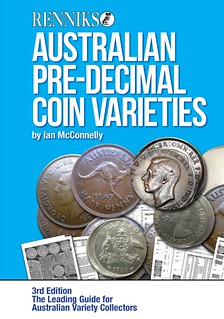 Renniks Australian Pre Decimal Coin Varieties 3rd Edition
Renniks Australian Pre Decimal Coin Varieties 3rd Edition
$34.95
ISBN: 9780987105707
The latest edition in ‘Australian Pre – Decimal Coin Varieties’ is now available! Compiled, written and researched by popular Coin and Banknote Magazine contributor, Ian McConnelly, this book is a must have
for all Australian Pre – Decimal variety collectors.
For more information, or to order, see:
Renniks Australian Pre Decimal Coin Varieties 3rd Edition
(https://renniks.com/shop/renniks-australian-pre-decimal-coin-varieties-3rd-edition-2/)
NEW BOOK: PAPER MONEY OF ESTATES OF SUMATRA
Ad Lansen has published a new book on the paper money of the estates of Sumatra. Congratulations! Here's the announcement. -Editor
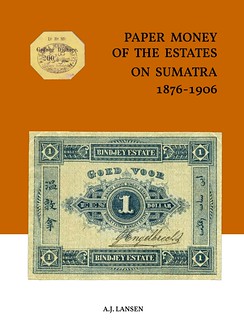 Now available, a new publication about the paper money used by the estates on Sumatra in the period 1876-1906. A brief description is given of each cultivation company, with an overview of all known issues (the main share of which is in the National Numismatic Collection, DNB), and a detailed description of each note. The publication is completely bilingual English-Dutch, with transcription of the headings in Chinese, Malay and Tamil, and richly illustrated in color. The author, Ad Lansen, is already known for his previous publications, including Plantation Tokens of the Dutch East Indies.
Now available, a new publication about the paper money used by the estates on Sumatra in the period 1876-1906. A brief description is given of each cultivation company, with an overview of all known issues (the main share of which is in the National Numismatic Collection, DNB), and a detailed description of each note. The publication is completely bilingual English-Dutch, with transcription of the headings in Chinese, Malay and Tamil, and richly illustrated in color. The author, Ad Lansen, is already known for his previous publications, including Plantation Tokens of the Dutch East Indies.
This new book has 126 pages in a4 format, with hard cover, is self-published and can be ordered from the author: Haanderik 94, 3401 et IJsselstein (nl), e-mail: a.j.lansen@hccnet.nl. Price: € 29.50 + postage.
NEW BOOK: PRISONER-OF-WAR CAMP MONEY
An article by Hans-Ludwig Grabowski on the Geldscheine Online site discusses a new book on prisoner-of-war camp money. Here's a Google translation. -Editor
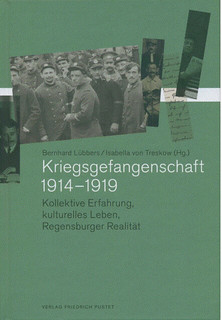 Bernhard Lübbers / Isabella von Treskow (eds.):
Bernhard Lübbers / Isabella von Treskow (eds.):
Captivity of War 1914–1919
Collective experience, cultural life, Regensburg reality
402 pages, black and white illustrations,
Format 15.5 cm x 23.2 cm, hardcover,
Regensburg 2019, published by Friedrich Pustet.
ISBN: 978-3-7917-3080-6.
Price: 39.95 euros.
After the prisoner of war newspaper "Le Pour et le Contre - Journal des Prisonniers de Regensburg", which was published in Regensburg during the First World War, was acquired for the holdings of the Regensburg State Library, this was the occasion for an extensive academic debate, not just up to then practically unexplored Regensburg camps, but on the subject of the German prisoner-of-war camps of the First World War in general.
As volume 2 in the series of cultural-historical research on captivity and internment in the First World War, the joint work presented here by various authors was published by Dr. phil. Lübbers and the holder of the chair for Romance Philology at the University of Regensburg, Dr. phil. von Treskow, was published.
Captivity became a mass phenomenon during World War I and part of 20th century history. On this occasion and based on the discovery of the prison newspaper of the Regensburg camp, the volume brings together 15 articles on the subject of prisoners of war in general (especially in Germany and with reference to France), on encounters between prisoners of various nations and origins, and on the prisoners' correspondence. The focus ranges from a local to an international perspective. Other neglected specifics such as camp fees, prisoner libraries, sound recordings made with prisoners and cultural camp life with theaters, music and camp newspapers are also discussed.
For the numismatist, the extremely interesting contribution by Prof. Dr. Hubert Emmerig from the University of Vienna on the camp money of the Regensburg prisoner of war camp in the First World War. As an introduction, the author naturally also addresses general questions about prisoner-of-war camp money. Why was there any storage fee at all? How did it come about? What types of camp money were there? Finally, using the example of the until then little known Regensburg prisoner of war camp, its monetary history and its use are documented.
All in all, a successful work well worth reading on a topic that has hitherto been neglected by historians, which also enables numismatists to gain knowledge and to think outside the box.
Everywhere in bookstores or directly via www.verlag-pustet.de (E-mail: bestellung@pustet.de), Tel. 0941 / 92022-321, Fax 0941 / 92022-330.
To read the complete article, see:
Kriegsgefangenschaft 1914–1919
(https://www.geldscheine-online.com/post/kriegsgefangenschaft-1914-1919)
BOOK REVIEW: CONFIDENT CARSON CITY COLLECTOR
Len Augsburger published a review in the March 2021 E-Gobrecht (the online publication of the Liberty Seated Collectors Club) about Rusty Goe's new three-volume work on Carson City coinage. With permission, we're republishing it here. Thanks! -Editor
Rusty Goe Publishes The Confident Carson City Collector
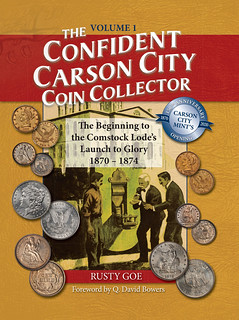 Following up on his previous books (The Mint on Carson Street, 2003, and James Crawford: Master of the Mint at Carson City, 2007), Rusty Goe is at it again, with a three-volume compendium on Carson City coinage, The Confident Carson City Collector. This is a massive work, weighing in at 2,500 pages, and we can be grateful it is split into multiple volumes. Let’s address the elephant in the room immediately – this is not a cheap set of books, and will run you around $300. But, if you intend to spend thousands of dollars on Carson City coinage (and you could easily spend a lot more), you will do well to allocate a few percent of your coin budget to education. Books play an important role, but do not form the whole picture – I highly recommend the ANA in-person grading course, and traveling to shows to compare coins face-to-face with other collectors can also be a learning experience.
Following up on his previous books (The Mint on Carson Street, 2003, and James Crawford: Master of the Mint at Carson City, 2007), Rusty Goe is at it again, with a three-volume compendium on Carson City coinage, The Confident Carson City Collector. This is a massive work, weighing in at 2,500 pages, and we can be grateful it is split into multiple volumes. Let’s address the elephant in the room immediately – this is not a cheap set of books, and will run you around $300. But, if you intend to spend thousands of dollars on Carson City coinage (and you could easily spend a lot more), you will do well to allocate a few percent of your coin budget to education. Books play an important role, but do not form the whole picture – I highly recommend the ANA in-person grading course, and traveling to shows to compare coins face-to-face with other collectors can also be a learning experience.
Back to Carson City coinage. The three volumes cover the periods 1870-1874, 1875-1885, and 1889-1893. For each of the 111 issues in the Carson City series, Goe has created separate historical and numismatic overviews. Yes, that comes out to an average of 22 (8.5x11) pages dedicated to every single Carson City coin. The historical overviews weave together a narrative of the goings on in Carson City, including the Mint, and these are not repetitive, they tell a whole story. The numismatic sections combine market information, price history, and Rusty’s inside knowledge of where all the important coins are. I have no doubt that if you sat down with Rusty for an extended chat about Carson City coinage, he could recite the stories of hundred of distinct specimens, off the top of his head. This is perhaps the most important part of the book – anyone can look up population reports and auction appearances, but Rusty has poured out his firsthand experience with the Battle Born collection (the only complete CC set, besides the Eliasberg collection), and many other important coins.
Rusty Goe relies on the written record as well, and has clearly spent a lot of time looking at microfilm of the Carson Daily Appeal and other regional newspapers. We also see research from the National Archives and Nevada State Museum, in addition to little-known numismatic sources such as the Thomas Hall notebooks recently digitized by Newman Portal. While historical background can add much to the appreciate of numismatic objects, some collectors are more motivated by market concerns and how to value Carson City coins. That’s all here too, with extensive discussions about why certain coins sold at the level they did. For those investing substantial amounts in Carson City issues, this detail is invaluable, taking you into Rusty’s head as a coin dealer and providing hundreds of case studies into how to evaluate specific coins. I, for one, won’t be buying any more Carson City coins without first consulting this reference.
What’s not here? Goe provides only high-level information on die varieties, which is already well-covered by Bugert, Fortin, Winter, Brunner/Frost, Osburn/Cushing, Briggs, and other references. Goe could have easily included a fourth volume on this topic, but little could be added to the excellent work that is already out there. The recently discovered coinage dies at the Nevada State Museum also deserve a book, but these pieces are not yet fully excavated or curated. We can hope that this is not Rusty’s last book!
The 3-volume set is available through Heritage (http://ha.com/CarsonCity) for $279 plus tax and shipping, or through the Southgate Coins site (https://www.southgatecoins.com/books-supplies/the-confident-carson-city-coin-collector) for $299 plus $16 shipping. Rusty’s first book, The Mint on Carson Street, is now out of print and has risen in value since the time of publication – unusual for recent numismatic books. This current series will clearly be the definitive work for a long time, and I would not be surprised to see similar demand for this multi-volume set.
For more information on the Liberty Seated Collectors Club (LSCC), see:
http://www.lsccweb.org/
To read the earlier E-Sylum article, see:
NEW BOOK: CONFIDENT CARSON CITY COIN COLLECTOR
(https://www.coinbooks.org/v24/esylum_v24n05a04.html)
DAVID JACOBSON WINS 2021 SHEKEL PRIZE
Mel Wacks submitted this announcement of the winner of the AINA's 2021 Shekel Prize. -Editor
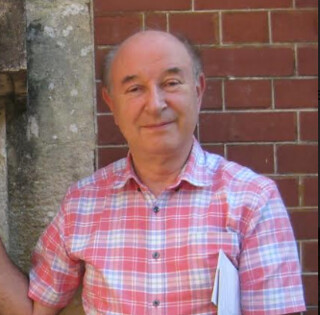 David Jacobson, Associate of the Faculty of Oriental Studies Faculty, University of Oxford, has
won the Shekel Prize Medal, awarded by the American Israel Numismatic Association for
David Jacobson, Associate of the Faculty of Oriental Studies Faculty, University of Oxford, has
won the Shekel Prize Medal, awarded by the American Israel Numismatic Association for
Agrippa II, the Last of the Herods
as the best 2020 publication on Judaic/Israel numismatics.
Upon receiving the news, Jacobson indicated: It is a great honour to be the recipient of this
prestigious award and I greatly appreciate the esteem of the members of the judging committee
of my endeavours.
Jacobson has described his attraction to the subject: What drew me to studying the coinage of
the last Herodian monarch Agrippa II, the last Herodian king in the Land of Israel were its
distinctive characteristics. His coin issues are prolific, almost equalling the combined total of all
the previous Herodian kings and tetrarchs. Its other striking feature was the closeness of its
various coin designs to those of Roman coins.
I quickly realised that the coinage of Agrippa II had hitherto not received adequate treatment and
so decided to investigate it myself. In my first study of this coinage, I was able to show that the
coin denominations reflect a move to integrate Agrippa II’s currency system with the Roman one
(Israel Numismatic Journal 19 (2016), 63-75). Delving deeper, I found that I could use the era
used on his coins to pinpoint the year of his death to 94/95 CE. Hitherto, the end of Agrippa’s
reign had remained an unsettled question, in contention among scholars.
When I began to examine Agrippa II’s coins, it struck me that there was no proper biographical
study of that king, so I decided to write my own account, which has now been published under
the title Agrippa II: The Last of the Herods. This monograph reveals important new facts about
him, his relationship with his sister Berenice and the reasons for Agrippa's abandonment of
the Jews during and after the war against Rome (the First Revolt). These findings are in addition
to what I have managed to learn about Agrippa II and his times from his coins. I hope that those
interested in the Herodian kings and numismatics will wish to read my book and perhaps find answers to some of their questions.
Herod Agrippa II never portrayed himself on his coins, but he did appear as a teenager on extremely rare issues of his father Herod Agrippa I struck 40/41 C.E. in Caesarea Philippi. Courtesy of Fontanille Coins.
The other entries for the 2020 Shekel Prize were Catalog of Paper Payment Tokens in Israel
by Alexander Golberg, Guide Book of Banknotes, Coins and Tokens of Israel
published by
Isranumis, and Medals of the Jewish-American Hall of Fame 1969-2019
by Mel Wacks. The
winning book and the other nominees are all available on amazon. The distinguished panel of
judges includes Dr. Haim Gitler, Israel Museum Curator of Numismatics; David Hendin,
American Numismatic Society Vice President; Simcha Kuritzky, President of AINA; Dr. Ira
Rezak, AINA Board Member; and the committee chair, Mel Wacks, President Emeritus of AINA.
Further information about past Shekel prize winners and the American Israel Numismatic
Association are available at
www.theshekel.org.
COINAGE OF 1888 DESIGNED TO AVOID SPECULATION
The latest addition to the Newman Numismatic Portal is U.S. Mint correspondence relating to the 1888 coinage. Project Coordinator Len Augsburger provided the following report. Thanks. -Editor
Coinage of 1888 Designed to Avoid Speculation
Recently added to Newman Portal is correspondence from the National Archives that reveals the rationale behind certain of the 1888 U.S. coinage. James Kimball, Mint Director, writes to Philadelphia Mint Superintendent Daniel M. Fox, ordering the additional coinage of 10,000 one-dollar gold pieces, 5,000 three-dollar gold pieces, and 10,000 three-cent nickels. Fox was instructed to put the coins directly into general circulation, so as to avoid speculation. Collectors by this time were already seeking out the scarce 1880s denominational silver coinage, as most of the Mint’s attention was diverted toward producing massive quantities of Morgan dollars under the directive of the 1878 Bland-Allison act. The 1888 coinage production, as directed by Kimball, succeeded in avoiding rarities, although the three issues mentioned here remain highly desirable to collectors today.
Image: 1888 $1 gold piece from the Newman collection, NGC MS63 CAC, ex Col. Green, Newman V (Heritage Auctions, November 2014, lot 7367, realized $1057.50).
Link to Mint Director Kimball correspondence on April 11, 1888 on Newman Portal:
https://archive.org/details/coinsmallgoldtoavoidspeculation18880411/mode/2up
Link to National Archives content on Newman Portal:
https://nnp.wustl.edu/Library/Archives?searchLetter=U
SYMPOSIUM: SS CENTRAL AMERICA DISCOVERIES
One of the headline presentations at the upcoming NNP Symposium is Bob Evans' talk on some of the unusual aspects of the SS Central America treasure. Here's the press release. -Editor
Ship of GoldBell Toll During Presentation By Bob Evans, March 21
Scientist Evans will show items from the legendary SS Central America during free online Newman Numismatic Portal Symposium
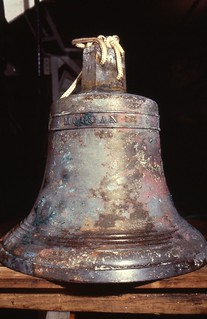 A sound only a few have heard since 1857 will be used to signal the start of a free online presentation as part of a Newman Numismatic Portal Symposium (
www.NNPsymposium.org) at 1 pm Eastern on Sunday, March 21, 2021. It is the ringing of the ship’s bell recovered from the fabled
A sound only a few have heard since 1857 will be used to signal the start of a free online presentation as part of a Newman Numismatic Portal Symposium (
www.NNPsymposium.org) at 1 pm Eastern on Sunday, March 21, 2021. It is the ringing of the ship’s bell recovered from the fabled Ship of Gold,
the SS Central America, that sank in 1857 while carrying crew, passengers, and tons of California Gold Rush-era treasures.
Scientist and historian Bob Evans, who was a key member on each of the recovery expeditions starting in the late 1980s, will present an illustrated talk entitled, SS Central America, Ship of Gold: Unusual Discoveries, Wonders, and Mysteries.
He will open his symposium session with a recording of the 268-pound bronze bell that was recovered from the Atlantic Ocean floor and has been in secure storage for more than three decades.

Of course, in addition to the thousands of retrieved numismatic items such as gold and silver coins, courageous miner’s gold dust and assayers’ ingots, the SS Central America was a time capsule of life during the California Gold Rush with fascinating personal items that were recovered. There are examples of gold jewelry showing the culture of San Francisco and pioneer Gold Rush society of the time, rubber and tortoise shell combs, steel pen nibs and quills, and other things that illustrate life during a transition to the Industrial Revolution,
explained Evans, a consultant to California Gold Marketing Group, owner of the treasure.
The SS Central America is the greatest American treasure ever found. Bob’s symposium will publicly reveal for the first time some of the more than 1,000 non-numismatic recovered items that now are being conserved and cataloged in Florida by Collectibles Authentication Guaranty (www.CAGcertified.com), a sister-company of Numismatic Guaranty Corporation (www.NGCcoin.com),
said Dwight Manley, Managing Partner of the California Gold Market Group. In the coming months, we’ll be revealing more information.
The SS Central America sank 7,200 feet under the surface of the Atlantic Ocean 150 miles off the North Carolina coast during a hurricane on September 12, 1857. She was on a voyage from Panama to New York carrying tons of California Gold Rush coins, ingots, and gold dust from the San Francisco and Northern California area. The tragedy took the lives of 425 of the ship’s 578 passengers and crew members, and the loss of the gold cargo was a major factor in the economically devastating financial panic of 1857 in the United States.
Free registration for the NNP Symposium can be done online at www.NNPsymposium.org, and registrants will receive Zoom links before the event. A full schedule of events is posted at www.NNPsymposium.org/schedule.
THE BOOK BAZARRE
VIDEO: MARCH 2021 COLLECTORAMA SHOW
These are selections from the David Lisot Video Library that feature news and personalities from the world of coin collecting. David has been attending coin conventions since 1972 and began videotaping in 1985. The Newman Numismatic Portal now lists all David’s videos on their website at:
https://nnp.wustl.edu/library/multimediadetail/522852
Here's one on the recent Collectorama show in Lakeland, Florida. -Editor
Collectorama Show Features Coins, Currency & Collectibles During COVID Crisis 2021.
VIDEO: 5:04.
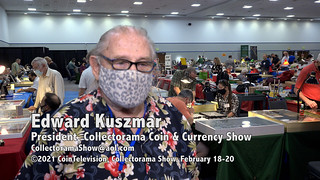 Edward Kuszmar, President, Collectorama Coin & Currency Show,
Edward Kuszmar, President, Collectorama Coin & Currency Show,
David Lisot, Interviewer, CoinTelevision.com.
February 18, 2021.
During the last year many larger coin conventions have been cancelled due to the COVID Pandemic. Edward Kuszmar was able to satisfy government bureaucracies and collector concerns by holding the 70th Collectorama Coin & Currency Show in Lakeland, Florida while the Corona Virus was still a threat. Ed explains what precautions were taken and why this convention is different from a normal coin show.
An excerpt of the video is available for viewing on the Coin Television YouTube Channel at:
https://youtu.be/DyIN3egsjSg
CHALLENGER WHISTLEBLOWER COMMEMORATIVE?
Vic Mason of Mamaroneck, NY submitted this suggestion for the U.S. Mint. Thanks. -Editor
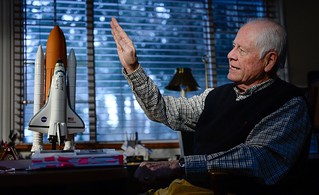 This note is motivated by the obituary column in Wednesday’s New York Times reporting the passing, at 83, of Allan J. McDonald, one of the engineers at Morton Thiokol who tried to stop the 28 January 1986 launch of the Challenger space shuttle, which broke apart 73 seconds after liftoff, killing teacher Christa McAuliffe and six other astronauts. The story is timely now that the United States Mint is preparing, 35 years later, to issue the 2021 Christa McAuliffe Commemorative Silver Dollar in her honor as the first participant in the United States National Aeronautics and Space Administration (NASA)
Teacher in Space program.
This note is motivated by the obituary column in Wednesday’s New York Times reporting the passing, at 83, of Allan J. McDonald, one of the engineers at Morton Thiokol who tried to stop the 28 January 1986 launch of the Challenger space shuttle, which broke apart 73 seconds after liftoff, killing teacher Christa McAuliffe and six other astronauts. The story is timely now that the United States Mint is preparing, 35 years later, to issue the 2021 Christa McAuliffe Commemorative Silver Dollar in her honor as the first participant in the United States National Aeronautics and Space Administration (NASA)
Teacher in Space program.
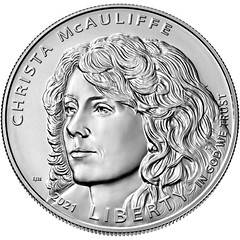 The Challenger launch, from the Kennedy Space Center in Florida, was coincidentally scheduled for the same day that President Ronald Reagan was to deliver his State of the Union address. Mr. Reagan had planned to mark the fact that Ms. McAuliffe would be the first American civilian astronaut in space, and NASA was keen to keep to the launch schedule. But the night before, the Morton Thiokol team would not agree to approve the launch because, based on previous experience, they feared that the severe cold that night – 18 degrees Fahrenheit – would cause the rubber O-ring gaskets on the booster rockets to stiffen, thereby likely causing a fuel leak and the potential explosion and destruction of the rocket.
The Challenger launch, from the Kennedy Space Center in Florida, was coincidentally scheduled for the same day that President Ronald Reagan was to deliver his State of the Union address. Mr. Reagan had planned to mark the fact that Ms. McAuliffe would be the first American civilian astronaut in space, and NASA was keen to keep to the launch schedule. But the night before, the Morton Thiokol team would not agree to approve the launch because, based on previous experience, they feared that the severe cold that night – 18 degrees Fahrenheit – would cause the rubber O-ring gaskets on the booster rockets to stiffen, thereby likely causing a fuel leak and the potential explosion and destruction of the rocket.
In a recent Netflix documentary, Challenger: The Final Flight,
Mr. McDonald pointed out that, under normal procedure, the engineers were always challenged to prove it was safe to launch.
But this time, wrote obit columnist Clay Risen, NASA was demanding that the Morton Thiokol engineering team prove that the mission ‘would fail, and we couldn’t do that.’
President Reagan set up a prestigious commission to investigate the disaster, headed by Secretary of State William P. Rogers and including astronauts Neil Armstrong and Sally Ride. The president had told Mr. Rogers to make sure that NASA looked good,
wrote Clay Risen. When NASA administrators and company leaders tried to cover up the reasons for the disaster, Mr. McDonald and another Morton Thiokol engineer, Roger Boisjoly, blew the whistle on them.
At that key moment in the hearings, Mr. McDonald stood up and contradicted the testimony to the commission of his company superiors, leading Secretary Rogers to clear the room. Wrote Mr. Risen: ...Ms. Ride came over and hugged Mr. McDonald. Both of them had tears in their eyes... The commission’s final report criticized both the design of the rockets and NASA’s decision to ignore the engineers’ concerns.
Morton Thiokol would subsequently punish McDonald and Boisjoly, who had provided the commission with internal company documents. When Congressman (now Senator) Edward Markey of Massachusetts heard of their treatment, he warned that the company would be frozen out of all future federal contracts unless the men were reinstated. Mr. McDonald was then promoted to vice-president in charge of redesigning boosters. (Mr. Boisjoly left the company.) Mr. McDonald’s superiors never forgave him for his disloyalty,
but in later years he went on the lecture circuit, speaking about corporate ethics and teaming up with academic experts on running leadership training seminars.
Mr. McDonald was born in Cody, Wyoming, and grew up in Billings, Montana, where US Mint Director David Ryder also is from. Mr. McDonald died last Saturday in Ogden, Utah.
To read the complete article, see:
Allan McDonald Dies at 83; Tried to Stop the Challenger Launch
(https://www.nytimes.com/2021/03/09/us/allan-mcdonald-dead.html)
For more information on the Christa McAuliffe Silver Dollar, see:
Christa McAuliffe Silver Dollar
(https://www.usmint.gov/coins/coin-medal-programs/commemorative-coins/christa-mcauliffe)
NOTES FROM E-SYLUM READERS: MARCH 14, 2021
More on the 1455 Calaisienne Medal of Charles VIILast week we discussed a great medal offered in the upcoming Lugdunum GmbH Spring sale. An email from Dr. Jonas Flueck got caught in my spam folder; sorry - here's a great photo and additional information on the medal. See the earlier article for a link to the video. -Editor
FRANCE, KINGDOM. Charles VII, 1422-1461. Large silver medal 1455 (Chronogram), unsigned, commemorating the expulsion of the English and the end of the Hundred Years’ war. 69 mm; 60.95 gr. Obverse: The King on horseback, armed from head to foot and with closed visor. Both he and his horse bear the blazon of France he has a drawn sword in his hand. Reverse: The King in majesty holding the sceptre and the sword. References: Trésors de Numismatique et de Glyptique pl. II, 2; Mazerolle, T. 3, 5; Vallet de Viriville 5; Collection Fillon 138 (this specimen); Collection Engel-Gros 100 (this specimen).
To read the earlier E-Sylum article, see:
THE 1455 CALAISIENNE MEDAL OF CHARLES VII
(https://www.coinbooks.org/v24/esylum_v24n10a19.html)
Pete Smith writes:
"I checked my copy of American Coin Treasures and Hoards by Q. David Bowers. On page 388 is a discussion of Romano's hoard of 1795 half dollars and proof 1878 trade dollars. There is no mention of a hoard of large cents or counterstamped coins.
"A few years back I did extensive research on Romno as I was preparing an exhibit of the Worthy Coin anniversary medals. I did not discover any reference to another hoard."
Denis Loring writes:
"Worthy Coin was run first by Corrado Romano, then jointly with his son Don, who eventually took over. They had a huge stock, including quantities of large cents by date. That's probably the "hoard" mentioned on the holder. J. J. Teaparty, run by Ed Leventhal, was right around the corner.
"To give you an idea of Worthy's stock, I once watched Corrado fill a mail order for a proof 3c nickel by carefully unrolling a paper-wrapped group of 50 coins, all 3c N proofs, picking one, and rewrapping the other 49."
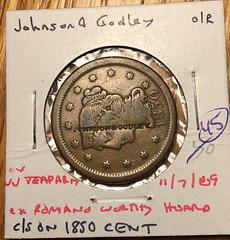
Thanks. Here's the coin that prompted Bob Merchant's query. -Editor
To read the earlier E-Sylum article, see:
NOTES FROM E-SYLUM READERS: MARCH 7, 2021 : Query: Romano Worthy Hoard
(https://www.coinbooks.org/v24/esylum_v24n10a08.html)
Dave Lange writes:
"The two-tailed Liberty Head Nickel brockage is datable to 1901 or later by use of the new reverse hub introduced that year. Most notably, the drooping leaf at the left side of the wreath is close to the top of the Roman V, while the old hub of 1883 shows it at a greater distance. The years 1901-02 were transitional, with reverse dies from either hub being seen. I'm attaching photos of the two hubs from NGC's VarietyPlus website.
"Speaking of NGC, I immediately recognized the photographic style used for the photo of an 1897 Morgan Dollar in Michael Merrill's item about the bag tag. Sure enough, it's from NGC's Coin Explorer website:"
Thanks. Nice photos! I wasn't aware of that detail. Reader Brian Schneider agrees.
I confirmed with Michael Merrill that NGC was indeed the source of the dollar photo. Great eye! -Editor
To read the earlier E-Sylum articles, see:
TWO-TAILED LIBERTY NICKEL BROCKAGE
(https://www.coinbooks.org/v24/esylum_v24n10a30.html)
NOTES FROM E-SYLUM READERS: MARCH 7, 2021 : 1897 Dollar Mint Bag Tag
(https://www.coinbooks.org/v24/esylum_v24n10a08.html)
John Sallay writes:
"John Kraljevich mentioned the New York Manumission Society’s African Free School and that reminded me of a short piece I wrote for the MCA Advisory back in 2006 (October 2006, pp. 4-6). The article was about a medal given by the New York Society for the Promotion of Education Among Colored Children. While these two societies were not directly related (I don’t think, anyway) I believe that the membership overlapped considerably, and their objectives were closely aligned."
Great medal! Thanks. -Editor
To read the earlier E-Sylum article, see:
ORELL COLORED SCHOOL MEDAL
(https://www.coinbooks.org/v24/esylum_v24n10a27.html)
IOWMC Vice President Bob Gabriel writes:
"The International Organization of Wooden Money Collectors (IOWMC) in its 57th year is one of only three Wooden Money Clubs left in the USA. In this month’s newsletter Bunyan's Chips
contains articles highlighting official wood issues from Lockport, Lyndon & Monee and Metropolis (home of Superman) Illinois. Monthly issues contain a Presidents message, Editor’s report and member advertisements buying, selling and trading of wooden money. There is also a monthly mail bid run by the club for its members, these auctions allow members to purchase wood at below market prices in an effort to keep the wonderful world of wooden money alive. Each month’s newsletter is also jam packed with articles relating to Wooden Money.
For information, please go to the club’s website http://www.woodenmoney.org or contact me at bgabrielone@yahoo.com for a sample newsletter or membership application."
Jeremy Schneider writes:
"I've got a challenge that the readers may be able to help me out with. I recently purchased a large collection (200+) of old bank bags, and one that I found in the lot was this- marked "Numismatic News Weekly, Iola. ,Wi 1000 PCS". I'm curious if this would have been some sort of give away, or had another purpose? Would the Mint have sent a bag of coins to the magazine? Any help cracking this mystery would be appreciated!"
Coin bags are a fun collectible - there are many different varieties issued by mints and banks alike. For assistance I reached out to longtime Krause Publications executive Clifford Mishler. -Editor
Clifford Mishler writes:
"It is probably a Fed/Mint bag of 1971-D Lincolns that was shipped to us by a coin wholesaler. Back in the early 1970s we offered a subscription promotion . . . the premium offered was a complete set of Lincoln Memorial cents in holder (1959-1973?) . . . which would have been the 15th anniversary. We offered a similar promotional program 10 years later for the 25th anniversary (1959-1983). "
We typically acquired our bags of promotional coins from Julian Jarvis of Greencastle, Indiana, or Virgil Marshall III of Wymore, Nebraska, either of whom may have been the originator of the shipment who stenciled our address on the bag.
Thanks! -Editor
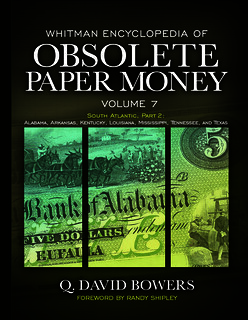 Regarding the Whitman Encyclopedia of Obsolete Paper Money
Steve Mengler of
Belle Plaine, IA writes:
Regarding the Whitman Encyclopedia of Obsolete Paper Money
Steve Mengler of
Belle Plaine, IA writes:
"I was wondering if you were aware of any future publication dates for books in this series after Volume 8. While I have been accumulating the earlier volumes, I am hoping that this series will continue to cover the Midwest states, particularly Iowa, Illinois, Wisconsin, Indiana, and Michigan."
I reached out the the publisher and received some good news. -Editor
Dennis Tucker of Whitman Publishing writes:
"Yes, we’re working on the Mid-Atlantic and Midwest states and territories now --- volume 9 (New Jersey and Pennsylvania), volumes 10 through 12 (New York, books I, II, and III), volume 13 (Illinois and Indiana), volume 14 (Michigan and Ohio), and volume 15 (California, Colorado, Iowa, Kansas, Minnesota, Missouri, Nebraska, Utah, and Wisconsin).
"These books are so research- and labor-intensive that I’m hesitant to give firm publication dates at this point."
Michael Wehner of the Pacific Coast Numismatic Society writes:
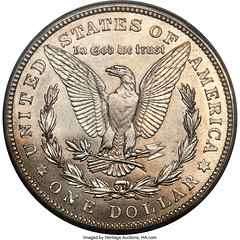 "A bit more info on the 1921-S Zerbe Proof Morgan dollar from the July 1921 issue of The Numismatist reporting on the May 1921 meeting of the Pacific Coast Numismatic Society.
"A bit more info on the 1921-S Zerbe Proof Morgan dollar from the July 1921 issue of The Numismatist reporting on the May 1921 meeting of the Pacific Coast Numismatic Society.
"The Secretary stated that Mr. Zerbe had obtained for the benefit of its members some carefully handled, specially selected specimens of the 1921 "S" mint dollars, and Mr. Zerbe would distribute them after the meeting, one to each member in exchange for their old cartwheels."
"There were 15 members, including Zerbe, at that meeting but no record of how many took him up on the offer. A while back we checked the PCNS archive but alas the Society did not put one away. But perhaps there are some still to be found in old San Francisco collections..."
Too bad. What a great opportunity! -Editor
To read the earlier E-Sylum article, see:
1921-S ZERBE PROOF MORGAN DOLLAR
(https://www.coinbooks.org/v24/esylum_v24n10a28.html)
Jim Duncan writes:
"I was surprised to see that bookfinder.com - which is available in seven languages - was not offered as a site. Not purely numismatic but very good!"
BookFinder.com is another fine used book search site. -Editor
To read the earlier E-Sylum article, see:
FINDING RARE NUMISMATIC LITERATURE ONLINE
(https://www.coinbooks.org/v24/esylum_v24n10a16.html)
Bob Leonard writes:
"I'm sure that this came to you like this, but I'm always annoyed by erroneous combinations of a decimal point and a dollar sign with the denomination. I assume that the new bill will be worth 52 cents U.S., not 0.52 cents. Writers should pick one or the other."
Yes, we were quoting the original article verbatim. It included BOTH the dollar sign and the word 'cents': "$0.52 cents". $0.52 = 52 cents. Either "$0.52" or "52 cents" would make sense, but combining the two is confusing. -Editor
To read the earlier E-Sylum article, see:
VENEZUELA ISSUES NEW INFLATION BANKNOTES
(https://www.coinbooks.org/v24/esylum_v24n10a34.html)
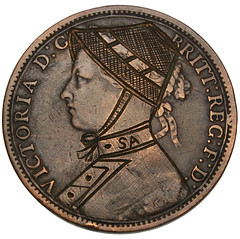 Regarding one of Jeremy Bostwick's Numismagram selections,
Harv Gamer writes:
Regarding one of Jeremy Bostwick's Numismagram selections,
Harv Gamer writes:
"I would like to add my observation on this item on the woman's collar the letters 'SA'. If you look at her bonnet and clothing the 'SA' would stand for SALVATION ARMY."
Phil Mernick writes:
"I am probably not the first person to mention this but in your Numismagram Selections 101543, Queen Victoria is wearing a Salvation Army bonnet and, in the UK, the SA on her collar is generally believed to stand for Salvation Army."
Daniel Fearon writes:
"It has nothing to do with South Africa or women's suffrage. It is the Salvation Army. The bonnet lasted till the 1960s. Certainly the women all wore them in my childhood in the '50s when their band played hymns in our street on Sunday mornings. Wikipedia devotes a whole page to them.
"The engraved coins are not rare, but as with so many things, were you to go out and try and find one, it might prove a hard job!"
For more information, see:
https://www.salvationarmy.org.uk/about-us/our-history
https://en.wikipedia.org/wiki/Salvation_Army_bonnet
Jeremy Bostwick writes:
"It’s an interesting thought, and obviously the imagery would work for the Salvation Army, but I’ve never found anything that points to these being made for those purposes. The only information that I’ve been able to uncover relates to the Boer War connection, and mentions these types specifically. It would be nice to find something more contemporaneous to when they were made mentioning them, which would certainly help narrow it down."
Thanks, everyone. -Editor
To read the earlier E-Sylum article, see:
NUMISMAGRAM SELECTIONS: MARCH 2021
(https://www.coinbooks.org/v24/esylum_v24n10a20.html)
Back in 2000 the Naples Bank Note Company (NBNC) intended to offer the European Central Bank the opportunity to have a US company print the Euro. In order to get samples to submit to the ECB, Naples Bank Note designed this One Million Euro Commemorative, complete with over 20 security features, including some never used before and only original to NBNC. These are the last sheets remaining. For collectors only.
MORE FROM E-SYLUM READERS: MARCH 14, 2021
John Mercanti Product Images SoughtDennis Tucker of Whitman Publishing writes:
"For the upcoming fourth edition of John Mercanti’s American Silver Eagles, I’m looking for high-resolution images (obverse and reverse) of the following medals and other U.S. Mint productions that John designed and/or engraved. I’ve queried the Mint, but I’d also like to see if any E-Sylum readers have good, clear images to share.
- 1982 Netherlands/America Enduring Friendship medal
- 1983 Fred Waring Congressional Gold Medal
- 1984 Leo J. Ryan Congressional Gold Medal
- 1984 U.S. Mint Set filler token
- 1985 President Harry Truman Congressional Gold Medal
- 1989 Mary Lasker Congressional Gold Medal
- 1992 Persian Gulf Conflict Veterans Medal
- 1992 General Norman Schwarzkopf Congressional Gold Medal
- 1993 U.S. Mint Director David J. Ryder medal
- 1995 Rabbi Menachem Schneerson Congressional Gold Medal
- 1995 U.S. Mint Director Philip Diehl medal
- 1997 Frank Sinatra Congressional Gold Medal
- 1998 U.S. Mint Service Award pin
- 2000 John Cardinal O’Connor Congressional Gold Medal
- 2002 General Henry H. Shelton Congressional Gold Medal"
Can anyone help? -Editor
Mary Herzog forwarded these additional photos of Martin Gengerke. Thanks! -Editor
To read the earlier E-Sylum articles, see:
MARTIN GENGERKE (1947-2020)
(https://www.coinbooks.org/v23/esylum_v23n51a09.html)
MORE ON MARTIN GENGERKE
(https://www.coinbooks.org/v23/esylum_v23n52a11.html)
Howard Daniel writes:
"It was a pleasure to see the profile of Dr. Helen Wang in The E-Sylum. She has been very helpful to me in my research over many, many years, and even as recent as last year when she sent me the images of some Republic of Viet Nam proofs that I requested. I was also fortunate to meet her in person many years ago when I was attending an International Bank Note Society Forum in London."
To read the earlier E-Sylum article, see:
SUBSCRIBER PROFILE: DR. HELEN WANG
(https://www.coinbooks.org/v24/esylum_v24n10a11.html)
Ross Johnson writes:
"Reading last week's E-Sylum, I spotted Dennis Tucker's submitted "Dennis the Menace" comic. It reminded me of the old television show from my youth, and of one episode in particular. Who knows why we remember such things? I hunted around on the internet, found it, and watched "Dennis and the Rare Coin" for a second time (in 60 years!).
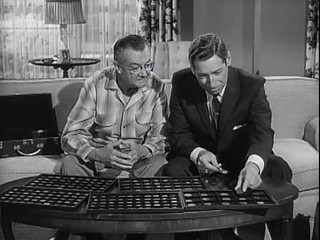 "Anyway, Mr. Wilson has indeed been a coin collector since at least the late 1950's. The episode centers around his purchase of a 1907 rolled edge "with periods" mint state eagle. Attempting to hide the "extravagance" from his long suffering wife, he hides the coin under a desk blotter. Mrs. Wilson later accidentally knocks it to the floor. Dennis finds the "special penny" and throws it into a wishing fountain! Pretty lame as situation comedy, and absolutely cringe worthy for a numismatist to watch, given the rough treatment the coin suffers. All is well in the end, (for us, not Mr. Wilson) since the coin turns out to be a fake!
"Anyway, Mr. Wilson has indeed been a coin collector since at least the late 1950's. The episode centers around his purchase of a 1907 rolled edge "with periods" mint state eagle. Attempting to hide the "extravagance" from his long suffering wife, he hides the coin under a desk blotter. Mrs. Wilson later accidentally knocks it to the floor. Dennis finds the "special penny" and throws it into a wishing fountain! Pretty lame as situation comedy, and absolutely cringe worthy for a numismatist to watch, given the rough treatment the coin suffers. All is well in the end, (for us, not Mr. Wilson) since the coin turns out to be a fake!
"In closeup it appears to be an actual Indian eagle in both obverse and reverse images. Mr Wilson, showing off his collection is also notable, as his vintage presentation of coin trays is a sign of the times... not a slab in sight!. The funniest moment is when the distraught Mr. Wilson declares "...only a chump would pay $250 for a ten dollar gold piece!"
Cool. Thanks! There are about a dozen episodes of the show with coins featured, ranging from an 1895 Silver Dollar to Dennis depositing pennies at a bank where Mr. Wilson works - see the earlier 2017 article linked below. -Editor
To watch "Dennis and the Rare Coin", see:
Dennis The Menace: S1 E15 - Dennis And The Rare Coin
(https://www.dailymotion.com/video/x74s7fk)
To read the earlier E-Sylum articles, see:
FEATURED WEB SITE: BRIANRXM
(https://www.coinbooks.org/v20/esylum_v20n43a23.html)
NOTES FROM E-SYLUM READERS: MARCH 7, 2021 : Dennis the Numismatic Menace
(https://www.coinbooks.org/v24/esylum_v24n10a08.html)
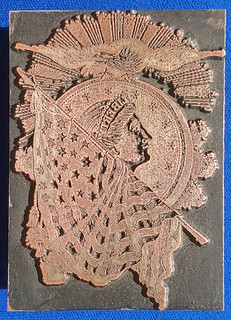 Dave Lange writes:
Dave Lange writes:
"I acquired a neat item on eBay recently. It's a small copper-on-wood printing block depicting the obverse of a Coronet Double Eagle with the USA flag suspended in front of it. Atop the coin is an eagle with a glory of rays behind it. I have no idea as to the publication for which this was created, but it undoubtedly dates to the period when such coins were in production."
Neat indeed! -Editor
Bill Rosenblum writes:
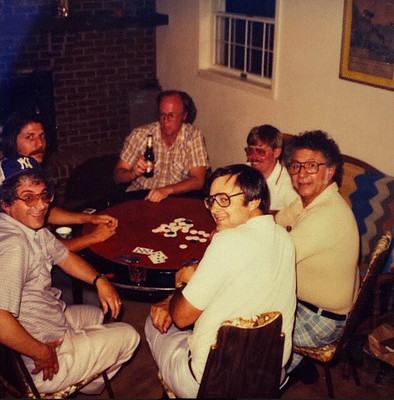 "Here is a photo from one of most unknown but exclusive numismatic organizations in Colorado History. PANDA was Poker and Numismatics in the Denver Area. We met 10-15 times a year from the mid 1970s to the mid 90s. This is probably from the early 1980s (1981-1982?).
"Here is a photo from one of most unknown but exclusive numismatic organizations in Colorado History. PANDA was Poker and Numismatics in the Denver Area. We met 10-15 times a year from the mid 1970s to the mid 90s. This is probably from the early 1980s (1981-1982?).
"That's me wearing the Yankee hat, going to the left from there is David Lisot (now in Dallas), David ""DD" Donald (now deceased), Dave Koble (of Mid American Currency in Oklahoma), Larry Lisot (David Lisot's dad and now deceased) and Victor England (pre CNG days before he moved to Pennsylvania.) Hal "Spike" Greimann took the picture. Probably taken at Dave Koble's house.
"Always fun to open a box that's been sitting on a shelf for 40 years."
Sounds like fun! Great photo. Thanks! -Editor
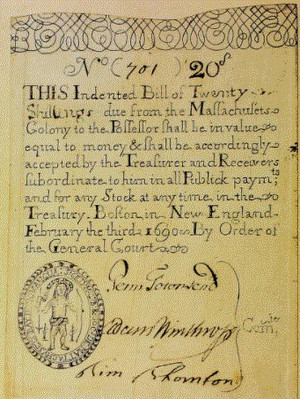 Darryl Atchison writes:
Darryl Atchison writes:
"Would anyone know of a published census of the paper currency issued in Massachusetts by William Phips after his failed invasion of Quebec in 1690?" One of these notes was sold in Ford Part III in May 2004 (lot no. 501) and a partial census of these notes in 1690/191 was included in the catalogue. I'm really wondering if there's a more complete census published anywhere since Stacks said this was just a partial census. There wasn't a single original note listed there which leads me to believe (or strongly suspect at least) that no originals still exist. Nonetheless, I would like to know if a more complete census exists."
Can anyone help? Here's an image of the lot, which was the Newman Plate note and realized $140,000 in the sale. -Editor
HARVEY STACK ON THE HOLLAND SALE
Last week we discussed the 1955 Pennypacker sale of the Ira Reed estate. An earlier article (linked in last week's issue) discussed the May 1959 Pennypacker sale of the Leonard M. Holland Large Cent collection. Harvey Stack was there and submitted this remembrance of the event. Thanks! First, here's the Kolbe & Fanning description of the sale from that earlier article. -Editor
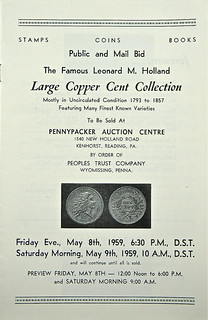 The Pennypacker sale was a remarkable event, offering a fine collection of large cents assembled in the late 1940s and 1950s, mostly acquired from Leonard Holland's good friend Thomas Elder. Holland pledged the collection as collateral for a construction project loan in the late 1950s. He encountered unforeseen difficulties and the bank foreclosed the loan, choosing an obscure country auctioneer to liquidate the collection. Distribution of the catalogue was limited and the coins generally sold for low prices. Some of the important collectors of the day did not learn of the sale and several of the attendees funneled their bids through a single agent.
The Pennypacker sale was a remarkable event, offering a fine collection of large cents assembled in the late 1940s and 1950s, mostly acquired from Leonard Holland's good friend Thomas Elder. Holland pledged the collection as collateral for a construction project loan in the late 1950s. He encountered unforeseen difficulties and the bank foreclosed the loan, choosing an obscure country auctioneer to liquidate the collection. Distribution of the catalogue was limited and the coins generally sold for low prices. Some of the important collectors of the day did not learn of the sale and several of the attendees funneled their bids through a single agent.
After the sale, it is reported that the coins were again auctioned within the group in a hotel room. Sometimes, the differences were dramatic, with coins subsequently bringing double or triple the original hammer price. Notables attending the sale included Ray Gallo, Louis Helfenstein, Dorothy Paschal, Gene Reale, C. Douglas Smith, Harvey Stack, Willard C. Blaisdell, Michael Kolman, Allen McDowell and Walter Breen.
Here are Harvey's recollections. -Editor
Shortly after a New York Numismatic Spring convention, a group of dealers and collectors ran off to the Pennypacker sale. A list of lots to be sold was distributed at the convention, and had enough information to attract quite a few.
My family saw the list, talked to a few specialized cent collectors, and they sent me to the sale. My folks thought if the coins were what were indicated in the listing, it would be worth a trip. Since a number of collectors and dealers were going, they felt that there could be a gang up by the buyers to "buy at bargain prices" some rare and unusual large cents. From my memory there were a few collectors who already banded together. I, as a known professional, was asked to go, and maybe be part of one of the groups that was going to work together.
My group included Louis Helfenstein, Gene Reale, C. Douglas Smith and Allen McDowell. One of the other groups included Ray Gallo, Dorothy Pascal (on behalf of Dr. Wm. Sheldon) and Walter Breen. A few independents were Willard C. Blaisdell, Michael Kolman (an Ohio Dealer) and a few unknown collectors.
The sale took place, each group worked with each other separately, but since I had Louis Helfenstein (a specialist collector) and C. Douglas Smith (a large cent specialist ) with me, we were able to properly mark our lots after we examined each coin, and decided that on many that we would buy them in tandem and then have a private auction after the sale. Our strength did outbid the others in most cases and our group captured most of the rarities and exceptionally choice examples.
Yes the other groups did participate, but they lacked what would they do if each wanted the same coin. They therefore dropped bidding on some. Our group captured most of the important lots, paid for them and then retired to a nearby hotel to auction among ourselves each lot we just acquired.
The idea was to have a starting price at the auction sale prices, and that we then could bid and make deals among ourselves what we were willing to pay, and the sale took place. As the only professional auctioneer in our group, I conducted the sale of each lot. Some sold for just a few bids above the "hammer price at the sale", others were bid on very competitively among our group and some record prices, for the time, were achieved. The realized prices yielded a profit, and it was divided among the bidders. I won a few important coins myself, and was excited that I was so successful. Even with the sales prices deducted from the "hammer price" all had made close to $1000 each. That was a tidy sum to earn for one day, and also gave each of us a profit. $1000 at that time was a lot of money to make for each of us for prices for rarities were always in the hundreds, rather than in the thousands.
Compared to today's market for similar coins, the prices today are much higher, and it would have lead to each of us who participated profits of probably as much as $10,000 each.
60 years later I am the only one still alive to have attended the sale, and able to tell a factual remembrance of the day at this now-famous auction!!!
The events of the day surely stick in my mind as a numismatic happening, and I am glad to provide some further details to your noteworthy story.
Yes indeed, there are a "million stories in numismatics to tell "!!!
To read the earlier E-Sylum article, see:
1955 PENNYPACKER IRA REED ESTATE SALE
(https://www.coinbooks.org/v24/esylum_v24n10a07.html)
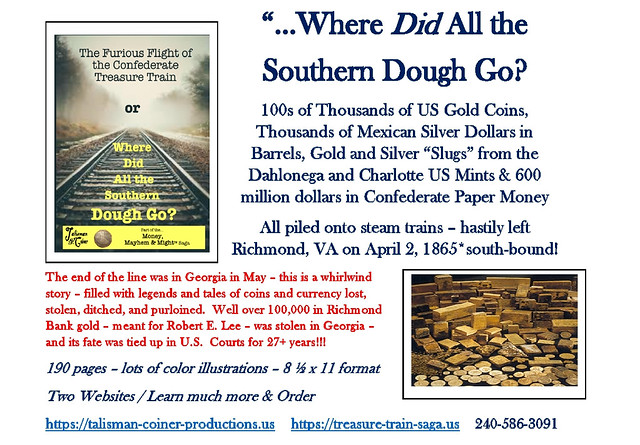
QUERY: COLUMBIA FARTHINGS
Dave Hirt writes:
"In the August 1937 Numismatist, page 717, John F Jones has a short article, with a picture titled Columbia Farthings. I had never heard of these items! Jones quotes Lyman Low, (who knew a bit about tokens), as saying, "From whence they came and whither going, no man knoweth"). They seem to have been struck in the early 1820's, and seem to be of British workmanship. Perhaps they circulated during the "Hard times period"..
"Low sold examples in his Cutting sale in 1898, as did David Proskey in his R. C. Davis sale in 1890. I am sure that some of our amazing readers know about these items also!"
Great question. I was unfamiliar with these as well. Here's an excerpt with a portion of the article image. -Editor
The late Lyman H. Low, in one of his earlier catalogues, listing these pieces, said: "From whence they came, and whither going, no man knoweth, " and most American writers on coins since then have accepted this statement as a fact.
In 1898 Mr. Low, in the Colonel Cutting catalogue, attributed fifteen of these pieces with bust to right, and two with bust to the left, seventeen pieces believed to be all different, " as belonging to the United States of Colombia, South America.
Before this in 1890, in the R. Coulton Davis catalogue, listed under the United States early colonial section—"Miscellaneous Pieces Used in America"—David Proskey, then one of our most learned numismatists, offered in No. 2457, "ten Columbia farthings, all from different dies, " without making any further comment, and in No. 2458 stated, "Similar (Columbia) obv. , reverse, crown between branches of oak, rose, thistle, and shamrocks;
It seems strange that Nelson, Atkins, Hazlitt and other English writers on the native copper coins do not mention these pieces, which in design and execution plainly show evidence of British fabrication during the 1820- 1830 period, and which must have been struck in large quantities and then shipped to America.
They are an interesting series, fairly well-coined, with enough variation in the dies to make them attractive to the new collector, besides being an inexpensive lot.
Probably seventeen different dies, with the additional rare muled coronation reverse, will cover all known varieties, but the question still remains: Are they to be classed like many other Irish tokens among our early U. S. colonials, or more properly attributed to the longing for justice and freedom (like unto "Columbia" ) among our Irish brethren across the sea, who perhaps flooded our land with these little tokens to awaken aid and sympathy for their cause?
A search on the Newman Numismatic Portal turned up this 2002 article from the Numismatics International Bulletin, Vol. 37, No. 5. -Editor
Jørgen Sømod, Frederiksberg, Denmark
Columbia Farthings is a name used by numismatists for some copper coins or tokens, which on the obverse shows a left or right-wing portrait of a man. If the portrait is right-wing it also will have above or below the legend COLUMBIA. The reverse shows a standing or sitting allegorical woman holding scales and a sword. An obverse-die with COLUMBIA above is known muled with the reverse-die to a jeton in occasion of the coronation of George IV 19th July 1821. The socalled Columbia Farthings look immediate like official English farthings from George IV and William IV and because of the known mule, dated 1821 it is stated, that they are struck in Birmingham. As far as known, they are cataloged first time in Josef Neumann, Bescreibung der bekanntesten Kupfermiinzen, Band 3, Prag 1863, where they are traced to the Southamerican country Columbia. Same tracing is found for the pieces, which were in the Jules Fonrobert collection, sold in Berlin 1878. Later times numismatists agree that they are not from the Southamerican country, because they never are found there.
It was suggested they were sent into circulation in areas in present Canada or U.S.A., but nobody could make any proof of it. Because of that Columbia Farthings have for a long time been one of the big mysteries in numismatics. The question about them were brought on the internet mailinglist coins@uni.edu. It was then shown, that Columbia Farthings were unknown to most American collectors and dealers and that they on the common American coinmarket are scarce. As an answer to the questions on coins@uni.edu Mr. John M. Kleeberg, ANS told: The American Numismatic Society has 28 Columbia farthings in its collection. Those with a provenance come from three sources: 1931.58 (one example) from the Canfield collection; Canfield was a US collector of the 1890s-1920s, who specialized in Connecticut coppers, but also collected many other series; 1940.88, (several examples), from the purchase of the collection of John F. Jones, a US collector of the 1890s-1920s, who sought to assemble an example of copper coins from every country in the world; 1975.117 (several examples), donation by Henry Gruenthal, probably the remnants of the Harry Prescott Clark Beach, Jr. collection, a collector of New Jersey coppers and other coins who was active in the 1920s- 1940s.
In the late nineteenth and early twentieth century Columbia farthings were collected in the belief that they were part of the US "colonial series." You should find them if you look through old Woodward, Frossard, or Steigerwalt catalogues. But that does not mean that they ever circulated here, because the dealers of the time often bought bulk lots in European auctions (we know that many US dealers were active buyers at the LeGras sale in Paris and at the Fonrobert sale in Berlin) or imported privately acquired bulk lots just to have material to sell to collectors. Columbia farthings are apparently absent from the most important Canadian hoard of coppers (12,000 coins, of which McLachlan went through 5,000): the Bank of Montreal hoard deposited in 1837 - see R. W. McLachlan, "A Hoard of Canadian Coppers" in: The Canadian Antiquarian and Numismatic Journal (July 1889) pp. 27-34. Columbia farthings also appear to be absent from the Aaron White accumulation (nearly 100,000 copper coins) of coppers of the 1860s, which was assembled in Connecticut: Walter Breen, "Survey of American Coin Hoards," The Numismatist, October 1952, pp. 1007-1010.
Further Mr. Andrew in United Kingdom could tell: Yes, the Columbia ‘Farthings’ are found in dealers’ miscellaneous boxes. I have four different varieties but know of another collector who has about nine. He also has a total of some 700+ of them so he has quite a lot of duplicates! They are quite common but I think interest in them is limited. If, however, we knew where and when they were used then it would be a different matter. Rather than noting where dealers have them it would be more interesting to find where metal detector users have dug them up. I believe they were used as currency of some sort, somewhere in the world. There are too many of them around and they often show signs of circulation for this not to be the case.
It can now be concluded, that Columbia Farthings alone were manufactured in Britain and sent into circulation in England. The former dating, round 1830, is undoubtedly correct. The question is now: Why were they made? As an answer should be mentioned, that for years it was in Britain a tradition, that the major part of minor currency was private tokens of which many were without a name or issuer, why these token issuers just by issuing made their profit. An Act of Parliament declared them illegal in 1817, except for tokens of the Birmingham Workhouse and Sheffield Overseers of the Poor which were current until 1820 and 1823 respectively. The token issuers got then their business destroyed. By using the word COLUMBIA, it may be assumed the issuers tried to let people believe that their illegal tokens instead were money from an area in North- or Southamerica. Because many areas had the name Columbia, it would be difficult or rather impossible to discover the swindle.
Dave Hirt adds:
"Thanks for the information. The Columbia pieces are a real numismatic mystery! That both you and I were unfamiliar with them is remarkable.
"The article in the Numismatics International Bulletin raises as many questions as answers to me. The article states that Columbia pieces may be found 19th century auction catalogs, Woodward, Frossard, etc, But I do not remember seeing them there.
"WHERE DID THEY CIRCULATE?? That McLachlan found none in a 12,000 pc Canadian hoard seems to rule out Canada. The same for the USA with none found in the Aaron White hoard of 100,000 pcs. Perhaps if an English collector had 700 of them, they were NOT exported. BUT, WHY don't English writers on copper coins and tokens mention them???"
All great questions. Can our readers provide any insight on this? Thanks. -Editor
BOOKHUNTING IN VIET NAM
Howard Daniel submitted this story about bookhunting in Viet Nam. Thanks! Great story. -Editor
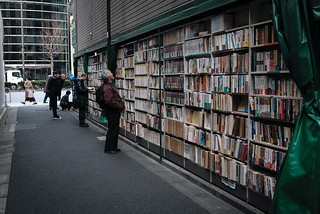 The first image in your item Finding Rare Numismatic Literature Online looks like an alleyway bookshop and it brought back some old memories to me.
The first image in your item Finding Rare Numismatic Literature Online looks like an alleyway bookshop and it brought back some old memories to me.
When I first went back to Viet Nam after the war in 1989, I found a used bookstore on the
main street in Ho Chi Minh City (Saigon). It contained thousands of books which were confiscated by the government from abandoned houses of people who got out of the city before April 30, 1975. I walked around inside and could not find anything so I stopped to talk to an old man working behind a counter. His name was Mr Le Thach and he spoke English. After I told him I was looking for old dictionaries, economic and banking histories, and books about coins and paper money, he asked me if I wanted books about Viet Nam! I told him if he had other than Viet Nam, I would be interested in seeing them, but I really wanted ones about Viet Nam. He was very pleasantly surprised.
Mr. Thach disappeared into a back room and came out with an old and large leather-bound Vietnamese dictionary that weighed at least 5+ pounds. Fantastic! It had the translations of Vietnamese words into Vietnamese, Vietnamese-Chinese calligraphy, French, and Latin! He told me it was very highly priced and I might not want to buy it. The price came to about US$40 and I could not get the money out of my wallet fast enough! He told me this was the largest amount of money anyone has spent with him. I told him I will spend more if he can find any more books of interest to me and that I will return in a couple of days.
A couple of days later, I came back and Mr. Thach had a stack of books under his counter waiting for me. I bought all of them and he was smiling from ear to ear. I told him I was going to have to leave some of them in Viet Nam with my wife’s family because my suitcase would weigh too much with all of the books. I told him I will try to be back next year and every year thereafter but I did miss two or three years in last 30+ years.
When I came back two years later, I could not find Mr. Thach in the bookstore and one lady told me he had opened his own bookstore. Wow! She gave me the address and it was in an alley about 20 feet from the bookstore! I went to it and Mr. Thach was very happy to see me. We did business together for about 15-20 years but he had to close down because the entire block where he was located was redeveloped into a huge mall with underground floors and a hotel on top of it. I used to visit him at his house but one day his son emailed me and said not to come around again. His father had developed dementia and could not talk with me like the old days. I learned he had passed away a year or so later when his son sent me an email. It was not only a terrible loss to me that he passed but also to the many other foreign and domestic customers he had.
To read the earlier E-Sylum article, see:
FINDING RARE NUMISMATIC LITERATURE ONLINE
(https://www.coinbooks.org/v24/esylum_v24n10a16.html)
VOCABULARY TERM: CURATING
Here's another entry from Dick Johnson's Encyclopedia of Coin and Medal Terminology. -Editor
Curating. The many curatorial duties to identify, catalog, preserve and protect specimens for study. Curators may be called upon for a variety of activities from appraising to exhibiting to writing about the objects under their care. But a curator may be said to be an administrator of objects. Of greatest importance is conservation and preservation – protecting and keeping these objects from damage, deterioration and disappearance. Fortunately numismatic objects are easy to preserve, since most are metal, but their small size can be a problem. Paper money and nonmetal objects have their own problems of preservation.
Of equal importance to preserving and protection is assisting scholars in dissemination information about the collection within the curator's control. The curator must be an accomplished numismatist. He (or she) must be able to arrange, house and retrieve specimens upon request. He must know the classification system his institution uses, to be able to create a numbering system to identify specimens in his collections, or new arrivals, and be able to create the paperwork to control their existence.
He must be able to accession new specimens and integrate these within the existing collections. He must be able to assign a unique accession number to new specimens. In rare occasions he will be called upon to deaccession duplicate or unwanted specimens.
As part of a numismatic record, the curator must know how to catalog. To arrange items for publication, to write up their descriptions and record their data. He must be familiar with literature in the field and have access to necessary reference works. Sometimes the curator needs to do laboratory testing and perform other tasks of authentication.
The curator must have a flare for display as exhibiting specimens is an important function of curating. He must have knowledge of how these objects tell a story and fit into a larger scheme of history or culture or heritage or the development of a theme. Usually exhibit space is limited so a choice must be made to select specimens that exemplify the theme of the exhibit. When objects are leant to other institutions he must prepare a condition report and check the condition on their return.
If the curator can write well, he is often called upon to write descriptions, an article, a scientific paper, or even a book. His institution will require him to write for their periodicals, newsletter, or other publications.
He must keep up with market values of the items within his chosen field. If his institution allows it, he can perform appraisals when requested.
And, always, are the questions to be answered. These come from within their own institution, from the press, from scholars, from academia, and from the public. The curator holds a unique position in which he has specialized knowledge which he must share with others. He needs to answer telephone inquiries and correspondence – sometimes repetitious – with courtesy and aplomb. Curatorial duties are many and varied.
To read the complete entry on the Newman Numismatic Portal, see:
Curating
(https://nnp.wustl.edu/library/dictionarydetail/515618)
FRANCIS RICHARD KIMBALL (1859-1922)
Here's another entry from the online draft of John Lupia's book of numismatic biographies. Thanks! This is an excerpt with the full article and bibliography available online. This week's subject is Boston dealer F. R. Kimball. -Editor
Francis Richard Kimball (1859-1922), was born on March 11, 1859, at Hopkinton, New Hampshire, son of Harvey Kimball (1822-1878), and Grace Judith Kimball.
He married Maria Putney Connor (1862-1910) and they had a daughter Grace Judith Kimball.
He was a member of the ANA and BNS.
He was a dealer in stamps and coins. He published Kimball's Illustrated Coin Guide.
About 1919 he had an automobile accident and broke one of his legs.
Later in 1919 he fell and broke the other leg. Soon afterwards he suffered three strokes.
In 1920, he was selling the 1869 reissue stamps advertising in MeKeel's Weekly Stamp News.
In 1921, he developed cancer.
About October 1921 he closed his office due to illness from cancer.
He died of arteriosclerosis on January 5, 1922, at Waltham, Massachusetts.
To read the complete article, see:
KIMBALL, FRANCIS RICHARD
(http://www.numismaticmall.com/numismaticmall-com/kimball-francis-richard)
HARVEY STACK'S NUMISMATIC FAMILY, PART 91
The latest article in Harvey Stack's blog series discusses the legendary 1983 Roper Collection sale of colonial and early American coins. Thanks! -Editor
December 1983 brought our sale of the spectacular John L. Roper Collection of Early American and Colonial Coins. We were honored to have been chosen to present this auction, comprising 684 lots of many of the choicest and rarest coins in this specialty, one of the most important collections ever formed and then sold at auction.
John L. Roper II, was a native of Norfolk , Virginia who traced his ancestors to the earliest settlers in this colony. Mr. Roper (whose friends called him Jack), was for decades CEO and president of the Norfolk Shipbuilding and Dry Dock Co. Active before, during and after World War II , their dry docks were used by many of the commercial and military ships of companies worldwide. In the early 1970s, under the direction of Jack and his sons, the company built a new dry dock facility to accommodate the largest ships that sailed the seven seas. Jack was dedicated to the City of Norfolk, was an active officer in several banks and work diligently with many charities. He loved the history of the Virginia settlement and the development of Norfolk. He decided to collect the money used in the colonies as a result of this great interest in the early days of his state and city. He loved to discuss the history of each colony and the evolution of the money that was used as our country grew from the earliest European settlers through the establishment of the United States of America. The Roper Collection contained a major assemblage of all the colonial coins struck, obtained from dealers like Stack's, and from auctions of his time, with many featuring some great pedigrees.
In the early 1970s, as a major officer of the United Virginia National Bank, Jack offered his collection for display in the lobby so others could learn about the country's monetary growth. Though the collection was to be on display for three to six months, it was very popular, with hundreds of thousands of children, adults and families visiting and learning, each coming away with greater knowledge of the nation's coinage history. In order to accommodate all the interested visitors, the exhibition was there for about two years.
Late in that same decade, Mr. Roper began discussions with Stack's about having his cabinet cataloged and offered for auction. He was very interested in featuring as much information about the coins as we could, so that it would become a lasting reference on the items and a tribute to his dedication to finding superb examples and building such an important collection. When he passed away in April 1983, Jack left instructions that Stack's, who had worked closely with him for many years, would offer his collection at public auction.
In order to prepare this important catalog, we had a team dedicated to the task. Norman, Larry and I were involved, but we also engaged noted numismatists David Sunderman and Richard Picker, both known specialists in colonial America. We wanted our promise to "Jack Roper" to be accomplished. And it was.
This was by far one of the most important collections to come on the market in many a decade.
Also included were United States half cents and large cents, territorial gold and foreign coins that circulated in the colonies.
The Roper Collection offered an opportunity to acquire some of the greatest rarities, varieties, and finest known pieces. It was known as the "Finest and most complete type collection of Colonial American coins offered for sale at public auction in almost a half a century!"
Closing out Stack's great year of 1983 with the sale of the John L. Roper Collection, reinforced our reputation as a leading numismatic auctioneer and dealer and we looked forward to more landmark sales in the years to come.
To read the complete article, see:
Harvey Stack Remembers: Growing up in a Numismatic Family, Part 91
(https://www.stacksbowers.com/News/Pages/Blogs.aspx?ArticleID=harvey-stack-remembers-part-91)
To read the earlier E-Sylum article, see:
HARVEY STACK'S NUMISMATIC FAMILY, PART 90
(https://www.coinbooks.org/v24/esylum_v24n09a23.html)
MEDALLIC ARTIST HEIDI WASTWEET
Louis Golino published a great article about medallic artist Heidi Wastweet on the Mint News Blog site. Here's an excerpt - be sure to read the complete article online. -Editor
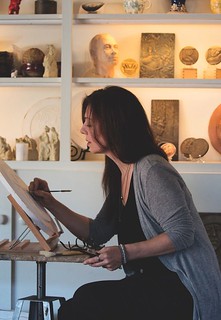 Heidi Wastweet is a name that is familiar to many collectors of modern coins and medals, especially those for whom the artistic aspect of coins is especially important.
Heidi Wastweet is a name that is familiar to many collectors of modern coins and medals, especially those for whom the artistic aspect of coins is especially important.
Heidi is a California-based sculptor who specializes in bas-relief sculpture that includes coins and medals as well as public art monuments. Bas-relief involves carving a design into a surface so that figures and motifs project slightly from the background.
Like many celebrated coin designers of the past such as American legends like Augustus Saint-Gaudens and Adolph Weinman, her true métier is sculpture, which is reflected in her medallic work that often features designs rendered with deep relief.
Since 1987 she has sculpted over 1,000 models for coins and related objects and often also does the designing for those works. Those pieces frequently include male and female figures and birds and other animals as well as motifs that are rooted in history or symbolism, which she carefully researches before creating a design.
In 2019 Heidi joined the United States Mint’s Artistic Infusion Program of outside artists who submit designs for U.S. coins and medals and work with the Mint’s permanent staff of artists and medallic sculptors.
Heidi served two four-year terms from 2010 to 2018 on the Citizen’s Coinage Advisory Committee (advising the Treasury Secretary on U.S. coin and medal designs) as specialist in sculpture/medallic arts; currently serves as president of the American Medallic Sculpture Association; annually teaches a popular medallic sculpture workshop at Brookgreen Gardens in South Carolina (a sculpture garden and wildlife preserve that also offers programs to train sculptors); is also active in many other professional associations such as the International Art Medal Federation (FIDEM) and the Medal Collectors of America (MCA), and is an elected member of the National Sculpture Association.
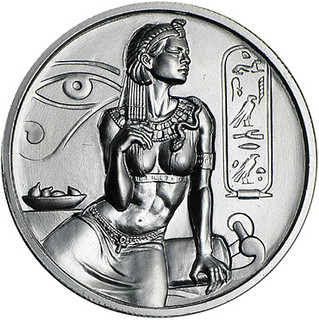 On January 23 Heidi gave a presentation to the Medal Collectors of America via Zoom titled
On January 23 Heidi gave a presentation to the Medal Collectors of America via Zoom titled Old Well, New Water
in which she discussed her approach to her work.
She began by noting that for her old and new are not in opposition to each other and that some key artists who influenced her include Italian Renaissance artist Pisandello, Laura Gardin Fraser (who designed the 1999 $5 gold commemorative of George Washington and was a sculptor), Adolph Weinman (who created the Mercury dime and Walking Liberty half dollar), and ancient Greek art. For her, Augustus Saint-Gaudens, who was considered the greatest American artist in his day, is the benchmark for medallic design.
To read the complete article, see:
Old Well, New Water
: Heidi Wastweet’s approach to medallic art
(https://mintnewsblog.com/old-well-new-water-heidi-wastweets-approach-to-medallic-art/)
BEP ARTIST LEN BUCKLEY TO SPEAK AT MPCFEST
Here the press release for the upcoming MPCFest for collectors of Military Payment Certificates and other areas of military numismatics. -Editor
Leonard Buckley, designer of military payment certificates (MPC) and fine artist will make the key note presentation at MPCFest XX/ZFest II on April 10 via Zoom.
Buckley is best known among MPC collectors as the designer of MPC Series 692 which is also widely recognized as the most beautiful series of MPC. Because of the extraordinary designs Series 692 is also of interest to many collectors who are not MPC specialists.
Len’s artistic career as a designer was focused on literally making money. Out of high school, he began a seven year apprenticeship in New York, training in the art of steel die and intaglio plate making used to print world-wide currencies, postage stamps and financial securities.
With a total of ten years experience, he moved on in 1967 to Washington DC. There he worked at the U.S. Treasury’s Bureau of Engraving and Printing as a bank note designer. After six years, he went on to become the supervisor of the bank note design staff. In his 32 years with the Bureau of Engraving and Printing, he was responsible for the designs of many postage stamps, currency, military payment certificates and security documents for the federal government.
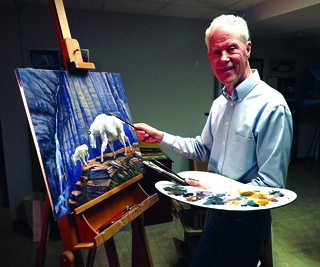 In his personal studio, he kept his artistic hand active, designing and illustrating for stamp and medallion collectibles. His renderings and paintings hang in private collections, some having been donated to the Smithsonian Institution’s collection in Washington, D.C.
In his personal studio, he kept his artistic hand active, designing and illustrating for stamp and medallion collectibles. His renderings and paintings hang in private collections, some having been donated to the Smithsonian Institution’s collection in Washington, D.C.
Since retirement from federal service, Len designed and rendered the Colorado State Quarter as part of the Artistic Infusion Program with the United States Mint. He stays active in the Baltimore Watercolor Society, the Washington Calligrapher’s Guild, the Hanover Area Arts Guild and the Adams Count Arts Council, wonderful outlets for his watercolor and oil paintings and pencil renderings.
Buckley's presentation at MPCFest will be at 1:30 PM (Festers 1330 hours) on April 10 via Zoom. If you are interested in attending the Fest, send your email request to the Fest registrar John Phipps at phippsjo2002@yahoo.com.
The MPCFest 2021 challenge coins continue the design and theme introduced in 2019. The obverse portrait features an artists rendition of the figure from the face of MPC Series 541 $5 certificates.
The theme was carried forward to 2020 when MPCFest 2020 was replaced with a Zoom Fest. The situation is repeated this year. Just as last year the Fest challenge coins will be available by preorder. A set consist of a .999 fine silver piece, a silver plated piece, and a bronze piece. Sets of three coins are available at $85 ($90 PayPal). Send your reservation to fredschwan@yahool.com and your payment by check (preferred, made out to Fred Schwan) to 132 E. Second St, Port Clinton, OH 43452. Additional bronze pieces may be ordered at $6 each. Coin will be shipped shortly after Fest 2021. Make your reservation not to guarantee your set.
Training is the mission of MPCFest. Each year collectors present information on military numismatic themes to the assembled throng.
Presentations can be on any of a wide range of topics under the umbrella of military numismatics. Presentations are as varied in their style as they are in subject matter. Some are only a few minutes while others are longer. Ray and Steve Feller are the Fest training officers. If you would like to make a presentation and Fest 2021, write to ray.feller@gmail.com Space is limited write now.
For details watch your MPCGram. For questions contact Fred Schwan at fredschwan@yahool.com. Attendance and participation are free thanks to the support of our Fest sponsors: Joe and Louise Boling, Steve and Ray Feller, Dave Frank, Al Glaser, Dave Hunsicker, Brett Irick, Harold Kroll, Bill Myers, David Seelye and Warner Talso.
FAROUK 1933 DOUBLE EAGLE RETURNS TO MARKET
Sotheby’s will auction the Farouk 1933 Double Eagle in June. Since 2002 it has been owned by Stuart Weitzman of New York. Here's an excerpt from the sale announcement. -Editor
Sotheby’s New York is pleased to present Three Treasures – Collected by Stuart Weitzman, a dedicated live auction of three legendary treasures from the personal collection of the renowned fashion designer and collector. On 8 June 2021 Sotheby’s will offer the fabled and elusive 1933 Double Eagle Coin, which set a world record when it last sold at auction in 2002, and the only example that is legally sanctioned by the United States government for private ownership; the sole-surviving example of the British Guiana One-Cent Magenta, the most famous and valuable stamp in the world; and The Inverted Jenny Plate Block, the most well-known and sought-after American stamp rarity. Iconic as they are rare, the Double Eagle and the British Guiana will be offered with estimates of $10/15 million each and are poised to set new world auction records in their respective categories, and the Inverted Jenny will carry an estimate of $5/7 million, set to eclipse its own record for an American philatelic item.
Richard Austin, Sotheby’s Global Head of Books & Manuscripts, commented: As the most aspirational objects in their respective collecting fields and each with their own illustrious provenance, the Double Eagle, the British Guiana and the Inverted Jenny all hold an indelible place in history, and in our collective imagination. Each treasure is unique in its own right: the 1933 Double Eagle as the only legally owned example, the British Guiana as the only one known, and the Inverted Jenny as the only plate block from a unique sheet of stamps. It would be a true privilege to present just one of these sought-after rarities at auction but offering all three one-of-a-kind treasures together in the same sale is a once-in-a-lifetime occurrence. It is a testament to Stuart’s perennial passion and dedication to his childhood ambition of acquiring these prized pieces that we are able to create a special moment to share their stories with the world at once.
Stuart Weitzman added: I had a life-long dream of collecting the single greatest rarities in the two great collecting areas of stamps and coins and then placing these extraordinary treasures, hidden away for decades, on continuous public view. I determined to do that, and I did that. That was my dream. Today my dream is to leave a legacy of charitable works to which the proceeds from the sales of these treasures will go.
The three treasures will be on public view by appointment in Sotheby’s York Avenue Galleries during New York Asia Week from 11 – 17 March as well as this May alongside the Contemporary and Impressionist Art exhibitions for our marquee spring auctions, and 5 – 7 June in the lead up to the auction on Tuesday, 8 June.
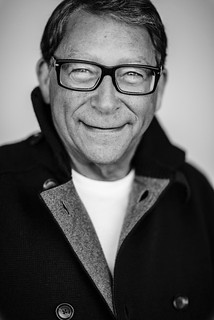 For more than 60 years, entrepreneur and philanthropist Stuart Weitzman pioneered luxury shoe design as founder of his eponymous company and is renowned for creating high-end shoes that are internationally beloved and synonymous with the pinnacle of luxury fashion design. In 2015, the Stuart Weitzman brand was acquired by Tapestry and remains one of the most highly sought-after luxury designers by celebrities and fashion lovers alike. Beyond his highly successful career in fashion, Weitzman is a life-long philatelist and numismatist with a deep appreciation for one-of-a-kind objects. Growing up collecting stamps and coins at an early age in Queens, New York, he fulfilled his boyhood pursuits at the highest echelon with his acquisition of the Double Eagle in 2002 and the British Guiana and Inverted Jenny Plate Block in 2014. Weitzman has been a generous steward of the three treasures, loaning the British Guiana to the Smithsonian National Postal Museum where it has been on public display since 2015 in its own special exhibition, as well as loaning the Double Eagle first to the Federal Reserve in Manhattan and then later to the New-York Historical Society Museum & Library. The Double Eagle has been exhibited at the New-York Historical Society Museum & Library since 2013 and was joined by the Inverted Jenny in 2014 following Weitzman’s acquisition of the plate block.
For more than 60 years, entrepreneur and philanthropist Stuart Weitzman pioneered luxury shoe design as founder of his eponymous company and is renowned for creating high-end shoes that are internationally beloved and synonymous with the pinnacle of luxury fashion design. In 2015, the Stuart Weitzman brand was acquired by Tapestry and remains one of the most highly sought-after luxury designers by celebrities and fashion lovers alike. Beyond his highly successful career in fashion, Weitzman is a life-long philatelist and numismatist with a deep appreciation for one-of-a-kind objects. Growing up collecting stamps and coins at an early age in Queens, New York, he fulfilled his boyhood pursuits at the highest echelon with his acquisition of the Double Eagle in 2002 and the British Guiana and Inverted Jenny Plate Block in 2014. Weitzman has been a generous steward of the three treasures, loaning the British Guiana to the Smithsonian National Postal Museum where it has been on public display since 2015 in its own special exhibition, as well as loaning the Double Eagle first to the Federal Reserve in Manhattan and then later to the New-York Historical Society Museum & Library. The Double Eagle has been exhibited at the New-York Historical Society Museum & Library since 2013 and was joined by the Inverted Jenny in 2014 following Weitzman’s acquisition of the plate block.
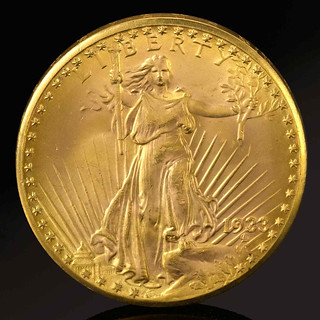 One of the rarest coins in the collecting field, the 1993 Double Eagle (estimate $10/15 million) twenty-dollar coin is completely unique in that it is the only one of its kind that may be legally owned by a private individual. When Weitzman anonymously purchased the coin at Sotheby’s New York in 2002 for $7.59 million, it established a new world auction record for any coin at the time, nearly doubling the previous record. The auction was conducted on behalf of the United States Government following a landmark legal settlement, which for the first and only time, authorized the private ownership of this 1933 Double Eagle alone. At the conclusion of the sale and in an historic moment, the Director of the United States Mint signed a Certificate of Monetization turning the coin into legal United States tender – the first time the United States Government had ever monetized a coin in this way.
One of the rarest coins in the collecting field, the 1993 Double Eagle (estimate $10/15 million) twenty-dollar coin is completely unique in that it is the only one of its kind that may be legally owned by a private individual. When Weitzman anonymously purchased the coin at Sotheby’s New York in 2002 for $7.59 million, it established a new world auction record for any coin at the time, nearly doubling the previous record. The auction was conducted on behalf of the United States Government following a landmark legal settlement, which for the first and only time, authorized the private ownership of this 1933 Double Eagle alone. At the conclusion of the sale and in an historic moment, the Director of the United States Mint signed a Certificate of Monetization turning the coin into legal United States tender – the first time the United States Government had ever monetized a coin in this way.
The 1933 Double Eagle has a uniquely captivating history which encapsulates large swathes of United States history and has been at the center of numismatic intrigue for more than 70 years. Known as the coin that took the US off the Gold Standard, 1933 Double Eagles were the last American gold coins struck and intended for circulation by the United States Mint but were never legally issued for use. Designed by the renowned sculptor Augustus Saint-Gaudens at the behest of President Theodore Roosevelt, its imagery of Liberty striding forward on the obverse, with an American eagle in flight on the reverse marks the apex of United States coin design. In 1933 President Franklin Roosevelt took the country off the gold standard in an effort to lift America’s tattered economy out of the Great Depression. Since they were never officially issued for use, all 1933 Double Eagle coins were ordered to be destroyed with exception of two examples set aside for the Smithsonian Institution. In 1937, several 1933 Double Eagles appeared on the market, which led to a Secret Service investigation in 1944 that deemed all newly discovered coins were stolen from the United States government and therefore illegal to own.
However, only weeks before the Secret Service investigation began in 1944, one of the 1933 Double Eagles was purchased and erroneously granted an export license. It entered the famed coin collection of King Farouk where it remained until 1954 when his collection was offered at auction by Sotheby’s, acting on behalf of the new Republic of Egypt. Upon learning of its presence in the sale, the United States Treasury successfully requested that the coin be withdrawn and the whereabouts of the coin remained a mystery until 1996 when it was seized during a Secret Service sting at the Waldorf-Astoria in New York. Following a five-year legal battle, which unearthed the long-forgotten and erroneously issued export license, the case was settled, and this single 1933 Double Eagle was permitted to be privately owned.
In 2005, ten more 1933 Double Eagles surfaced in the possession of the family of one of the individuals investigated in the 1944 Secret Service investigation and another legal battle ensued. More than a decade later, after a jury trial and appeals (to as high as the Supreme Court), 1933 Double Eagles were ruled property of the United States and therefore, with the exception of Stuart Weitzman’s example, can never be sold (following the litigation another 1933 Double Eagle was voluntarily surrendered to the US government).
To read the complete article, see:
Three Treasures – Collected by Stuart Weitzman
(https://www.sothebys.com/en/digital-catalogues/three-treasures-collected-by-stuart-weitzman?locale=en)
Len Augsburger and Chris Neuzil passed along a New York Times article. Here's an excerpt. -Editor
For years, Weitzman kept quiet about his collecting, not wanting the publicity. In 2012, 10 years after he had bought the double eagle, it was the centerpiece of a display at the Federal Reserve in Lower Manhattan. David Tripp, the special consultant to Sotheby’s on coins, did not know who owned the coin when, at the opening of the exhibit, he was approached by David N. Redden, the Sotheby’s executive who had handled the auction in 2002. Redden had two people in tow.
David said, ‘I’ve got a friend here with his daughter. His name is Stuart. Tell him about the coin,’
Tripp recalled.
Tripp, unsuspecting, went on to describe the particulars of the coin to the man who owned it.
Years later,
Tripp said, when David told me Stuart Weitzman was the owner, Stuart Weitzman the great designer of shoes, I clicked on Google and said, ‘I’ve met that guy before.’
To read the complete article, see:
He Owns World Famous Stamps and a Prized Coin. Now He’s Selling.
(https://www.nytimes.com/2021/03/10/arts/design/stuart-weitzman-stamps-coin-auction.html)
MUENZEN GUT-LYNT ONLINE AUCTIONS
This press release announces a new online auction house. -Editor
Muenzen Gut-Lynt: A New Platform For Online Auctions and Numismatics
Muenzen Gut-Lynt is a new online auction house for numismatics. The brand was established by renowned dealers and auction houses from Switzerland and Germany. On 28 March 2021, they will be holding their first auction with over 950 pieces.
The new online auction house is based just outside Düsseldorf in the manor house of an old Lower Rhine estate, the eponymous Gut Lynt.
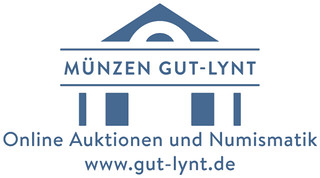 On 28 March 2021 at 11 am, it will be time for Gut-Lynt, the new online auction house for numismatic coins, to hold its Auction 1. This project is the product of friendly cooperation between renowned dealers and auction houses from Switzerland and Germany. Their goal is clear: to stimulate the market for buying and selling in numismatics.
On 28 March 2021 at 11 am, it will be time for Gut-Lynt, the new online auction house for numismatic coins, to hold its Auction 1. This project is the product of friendly cooperation between renowned dealers and auction houses from Switzerland and Germany. Their goal is clear: to stimulate the market for buying and selling in numismatics.
Online trade is booming – and it’s no different in the numismatics industry. Of course, this is partly due to the strange times we’re living in. In this respect, the launch of ‘Muenzen Gut-Lynt – online auctions and numismatics’ is very much on-trend. But when a new project is launched by prominent dealers and auction houses, you know it’s anything but a rush job. The newly established online auction house is based in the manor house of an old Lower Rhine estate, located just outside Düsseldorf. Preparations for the auction premiere on Sunday 28 March are in full swing– coins are being described, evaluated and put online.
With a straightforward elegance and functional clarity, the website already presents some of the 950 lots that will be up for sale at Gut-Lynt Auction 1. ‘All pieces will go online on 5 March 2021,’ reveals Managing Director and former President of the ‘International Association of Professional Numismatists’ (IAPN) Arne Kirsch. ‘We and our partners had been carrying around the idea and concept for the new project for several years,’ he explains, ‘Then, in the summer of last year, it took concrete shape. We started looking for the name and developing the brand. – What we and our partners had in mind was an online auction house where collectors and dealers get security and quality. We wanted to create a platform that, though it may not reinvent the wheel, learns something from the competition and brings something new to the table – that was important to us. We want to breathe new life into the numismatics market.’
The Well-Known Partners Behind Muenzen Gut-Lynt
The partners behind Muenzen Gut-Lynt are names that we in the numismatics world know only too well: SINCONA AG, based in in Zurich/Switzerland and Weil am Rhein/Germany, the traditional, Frankfurt am Main-based auction house Dr. Busso Peus Nachf., Münzen Frank OHG from Nuremberg and Frankfurter Münzhandlung (Frankfurt/M).
If you ask Arne Kirsch what makes Muenzen Gut-Lynt special, his answer is down-to-earth and confident: ‘As I said, we’re not reinventing the wheel. But there’s one thing our customers can rely on: Muenzen Gut-Lynt is built on trust. It is based on excellent industry knowledge and a passion for numismatics. We all provide individual support and advice on buying and selling, and we take the time needed to find the right solutions for consignors and collectors. Another factor that makes Muenzen Gut-Lynt an ideal contact for consignors of high-price collections is our partners. We are offering all channels for selling coins: direct sale via one of our partners, placement in internationally renowned gallery auctions in Frankfurt/M or Zurich – or even in online auctions, whose interesting range of pieces are sure to draw in collectors.
You can find more information on the Muenzen Gut-Lynt website:
https://www.gut-lynt.de/home-en
WORLD BANKNOTE AUCTIONS SALE 6 SELECTIONS
Here are some lots that caught my eye in the World Banknote Auctions Sale 6, which closes on March 25, 2021. -Editor
Armenia 1919 (ND 1920) P-32 PMG Gem UNC 65 EPQ 250 Rubles
Popular type from Armenia. While uncirculated examples come around from time to time, most are fairly ugly. This one is above average.
I guess it's the colors I like on this one. Nice example. -Editor
To read the complete lot description, see:
Armenia 1919 (ND 1920) P-32 PMG Gem UNC 65 EPQ 250 Rubles
(https://www.worldbanknoteauctions.com/lots/view/4-1XV41G/armenia-1919-nd-1920-p-32-pmg-gem-unc-65-epq-250-rubles)
China, Chartered Bank of India, Australia & China 2.5.1927 P-S184 PMG Fine 12 5 Dollars
Challenging issue from one of the Foreign Banks that was allowed to issue paper money in China in the 1920s. Like most of this time period seen with extensive signs of circulation, but the overall eye-appeal of this pieces is above average. PMG Mentions "Rust, ink".
Interesting foreign bank issue. -Editor
To read the complete lot description, see:
China, Chartered Bank of India, Australia & China 2.5.1927 P-S184 PMG Fine 12 5
(https://www.worldbanknoteauctions.com/lots/view/4-1XV46E/china-chartered-bank-of-india-australia-china-251927-p-s184-pmg-fine-12-5-dollars)
De La Rue Currency (GBR) 2004 PMG Gem UNC 66 EPQ 100 Units Test Note
Test notes are worth a study in themselves. Nice item. -Editor
To read the complete lot description, see:
De La Rue Currency (GBR) 2004 PMG Gem UNC 66 EPQ 100 Units Test Note
(https://www.worldbanknoteauctions.com/lots/view/4-1XV48E/de-la-rue-currency-gbr-2004-pmg-gem-unc-66-epq-100-units-test-note)
Faeroe Islands 2003 P-26 PMG Seventy Gem UNC 70 EPQ * 200 Kronur
PMG Population in 70 EPQ *: 5 (0 Finer)
I don't love the colors, but it's unusual and stands out from other banknotes. Interesting closeup view. -Editor
To read the complete lot description, see:
Faeroe Islands 2003 P-26 PMG Seventy Gem UNC 70 EPQ * 200 Kronur
(https://www.worldbanknoteauctions.com/lots/view/4-1XV4AY/faeroe-islands-2003-p-26-pmg-seventy-gem-unc-70-epq-200-kronur)
Great Britain ND (1915) P-348b PMG Very Fine 25 10/- Shillings
Overprint in Arabic for use by the British Military Expeditionary Forces in the Mediterranean and the Naval Expeditionary Forces in 1915-1916. Very scarce type regardless of grade, these are a fascinating remnant of World War I. PMG Mentions "Annotations"
Nice overprint note. -Editor
To read the complete lot description, see:
Great Britain ND (1915) P-348b PMG Very Fine 25 10/- Shillings
(https://www.worldbanknoteauctions.com/lots/view/4-1XV4D0/great-britain-nd-1915-p-348b-pmg-very-fine-25-10-shillings)
Iceland 2001 (ND 2013) P-61 PMG Gem UNC 66 EPQ 10,000 Kronur
Highest denomination from the current series of Iceland. Face value of about 80 USD and surprisingly difficult to find in the marketplace. One of those modern European issues that might prove a worthwhile investment once they are withdrawn from circulation.
I like the color, and I dunno, I guess I think Iceland is cool. -Editor
To read the complete lot description, see:
Iceland 2001 (ND 2013) P-61 PMG Gem UNC 66 EPQ 10,000 Kronur
(https://www.worldbanknoteauctions.com/lots/view/4-1XV4DW/iceland-2001-nd-2013-p-61-pmg-gem-unc-66-epq-10-000-kronur)
Netherlands Indies 15.6.1940 P-108a PMG About UNC 55 1 Gulden
I like the color combination and coin image. -Editor
To read the complete lot description, see:
Netherlands Indies 15.6.1940 P-108a PMG About UNC 55 1 Gulden
(https://www.worldbanknoteauctions.com/lots/view/4-1XV4JI/netherlands-indies-1561940-p-108a-pmg-about-unc-55-1-gulden)
Uruguay, Banco Italiano 20.9.1887 P-S215r PMG Choice UNC 64 100 Pesos (Remainder)
Early private issue from Uruguay. In our opinion fully original and making claims to a Gem Uncirculated grade.
Great gravity-defying mustache! -Editor
To read the complete lot description, see:
Uruguay, Banco Italiano 20.9.1887 P-S215r PMG Choice UNC 64 100 Pesos (Remainder)
(https://www.worldbanknoteauctions.com/lots/view/4-1XV4OO/uruguay-banco-italiano-2091887-p-s215r-pmg-choice-unc-64-100-pesos-remainder)
HERITAGE MARCH 2021 PARTRICK SALE SELECTIONS
Here are some items that caught my eye in the upcoming Heritage sale of the Donald G. Partrick collection of U.S. colonial coins. -Editor
(C. 1663-1672) Small Size St. Patrick, Gold--Scratched--NGC Details. AU. W-11530, Martin 1a.2-Ba.14, Unique. 184.9 grains. This example with a provenance dating to the late 1700s is the only genuine gold St. Patrick coin known today. It is the piece that appeared in the June 1909 Sotheby, Wilkinson & Hodge sale of the Rashleigh Collection that passed from Philip Rashleigh of Menabilly in the late 18th century to his great nephew, Jonathan Rashleigh, and to his son, Evelyn William Rashleigh. Plated in the 1909 Rashleigh catalog with the scrape across the cathedral visible in that appearance.
A second gold example was offered in the Norweb sale in 1988. That plain-edge piece was from the same dies as silver examples that Eric P. Newman identified as counterfeit in his article, "A Snake Breeds a St. Patrick Farthing," that appeared in The Numismatist of May 1962. The Norweb gold counterfeit failed to sell.
Interesting piece with a great provenance. -Editor
To read the complete lot description, see:
(C. 1663-1672) Small Size St. Patrick, Gold--Scratched--NGC Details. AU. W-11530, Martin 1a.2-Ba.14, Unique. ..
(https://coins.ha.com/itm/colonials/-c-1663-1672-small-size-st-patrick-gold-scratched-ngc-details-au-w-11530-martin-1a2-ba14-unique/a/1330-15006.s)
1670-A French Colonies 15 Sols, W-11610, Martin 1.2-B.1, VF30 NGC. The Edict of February 19, 1670, authorized coinage for Nouvelle France or "New France," the French colonization of the shores of the St. Lawrence River, Newfoundland, and Nova Scotia, eventually reaching the Great Lakes region. The 1670 edict authorized coins valued at two sols (the double denier), five sols (1/12 ecu), and 15 sols (1/4 ecu). The A mintmark on these pieces indicates their production at the Paris Mint. Robert Vlack reported that 200,000 five sols coins and 40,000 15 sols coins were sent to Canada. While there were no coins struck for exclusive use in Canada, these pieces were intended to be used in all of the French New World colonies including Canada and the Caribbean.
Despite the seemingly substantial distribution of these coins, they are extremely rare today, and most survivors are found in museum collections. Michael Hodder's census in the 2006 Ford catalog indicates that three examples are held in the Bank of Canada Collection, and one each at the Smithsonian Institution, Colonial Williamsburg, the Bibliotheque Nationale, the British museum, and the American Numismatic Society. Five or six others are in private hands.
A rare denomination of an historically important piece. -Editor
To read the complete lot description, see:
1670-A French Colonies 15 Sols, W-11610, Martin 1.2-B.1, VF30 NGC. ...
(https://coins.ha.com/itm/colonials/1670-a-french-colonies-15-sols-w-11610-martin-12-b1-vf30-ngc/a/1330-15007.s)
1786 New Jersey Copper, Date Under Plowbeam, Maris 7-E, W-4710, High R.7, VF30 NGC. 150.0 grains. Among the finest examples known of this legendary rarity in the New Jersey series. The coin is well-centered and well-struck, with the usual soft strike in the centers relegated mostly to the reverse. Indeed, while this piece ranks third in the condition census, the horse's facial features are more distinct here than on the example ranked second. The surfaces exhibit a light golden-tan patina that is both pleasing and natural. While the fields are mildly microgranular, there are few marks worth mentioning, and some minor roughness at the rims is commensurate with the grade assigned. An unusual characteristic of this piece, shared with the finest known Maris 7-E sold in our January 2021 offering of highlights from the Partrick Collection and at least one other example, is its die orientation: while most New Jersey coppers are struck in the familiar 180° "coin turn" alignment, this piece is struck at about a 10° alignment, nearly what is known as "medal turn." This example is of perfect weight, as the act establishing the New Jersey coinage specified a statutory weight of 150 grains. We note that the NGC grade is precisely the same as that given by Michael Hodder when he cataloged this piece for the 1987 Norweb sale: a consistency that speaks well of the coin.
Only two obverse dies were used to produce the distinctive Date Under Plowbeam type: obverses 7 and 8, as listed by Edward Maris in his 1881 A Historic Sketch of the Coins of New Jersey, the classic work on the subject. Maris 7 is found paired with reverse E (as here); a unique pairing with reverse C is also known. Obverse 8 is encountered paired with reverse F in what is the only known use of either die. Of the three resulting die varieties (Maris 7-C, 7-E, and 8-F), there is a total of only ten known coins, making the New Jersey Date Under Plowbeam among the rarest of all colonial types.
The Date Under Plowbeam type was first brought to the attention of collectors in 1860, when it was included in a supplementary listing to the second edition of Montroville Dickeson's American Numismatic Manual, in which one was said to be in the collection of Boston numismatist Jeremiah Colburn. The present example was not offered publicly until the 1987 Bowers & Merena sale of Part One of the Norweb Family Collection, the catalog for which revealed that it had been sold privately to Emory May Norweb on August 1, 1958, by the Empire Coin Company, having previously been "the highlight of the personal collection of James F. Ruddy." This is only the second time that this coin has been offered for open bidding.
The Norweb specimen; nice example of this rare variety. -Editor
To read the complete lot description, see:
1786 New Jersey Copper, Date Under Plowbeam, Maris 7-E, W-4710, High R.7, VF30 NGC. ...
(https://coins.ha.com/itm/colonials/1786-new-jersey-copper-date-under-plowbeam-maris-7-e-w-4710-high-r7-vf30-ngc/a/1330-15023.s)
1787 Machin's Mills Halfpenny, Vlack 18-87C, W-7930, High R.4, AU58 NGC. A short diagonal die crack from the border over Britannia's head suggests a late die state for this olive- and mocha-brown near-Mint halfpenny that is attributed to Thomas Machin's Mint in Newburgh, New York. Vlack 18-87C is a scarce variety that is occasionally found in higher grades. This piece is apparently in the Condition Census for the variety. Listed on page 71 of the 2021 Guide Book.
Nice high-grade piece. -Editor
To read the complete lot description, see:
1787 Machin's Mills Halfpenny, Vlack 18-87C, W-7930, High R.4, AU58 NGC. ...
(https://coins.ha.com/itm/colonials/1787-machin-s-mills-halfpenny-vlack-18-87c-w-7930-high-r4-au58-ngc/a/1330-15139.s)
(1800) Washington Funeral Medal, Gold--Obverse Scratched--NGC Details. AU. Baker-166, Fuld 2-C1, Musante GW-70A. 197.8 grains. 29 mm, plain edge. The death of George Washington on December 14, 1799 came as a shock to American citizens. He was mourned for months, and public and private ceremonies were held across the country. In Boston, a Masonic ceremony was held on February 11, 1800, and a civic funeral procession took place on Washington's birthday, February 22.
Newburyport, Massachusetts engraver Jacob Perkins produced funeral medals for both services. Baker-165, the rare Skull and Crossbones variety, was worn at the Boston Masonic service. Baker-166 and the rare Baker-167 were made for the civic procession. Baker-166 was struck in multiple die combinations and in four different alloys, with silver and white metal the usually encountered metals.
A classic piece, rare in gold. -Editor
To read the complete lot description, see:
(1800) Washington Funeral Medal, Gold--Obverse Scratched--NGC Details. AU. Baker-166, Fuld 2-C1, Musante GW-70A....
(https://coins.ha.com/itm/washingtonia/-1800-washington-funeral-medal-gold-obverse-scratched-ngc-details-au-baker-166-fuld-2-c1-musante-gw-70a/a/1330-15159.s)
(1793-99) Philadelphia, Pennsylvania, Ricketts's Circus, R. E-PA-429, Julian UN-32, R.8, AU55 NGC. 84.3 grains. Copper, reeded edge. Original examples of the Ricketts's Circus tokens exist in copper and silver, and they are extremely rare in either composition. Original 18th century strikes are on thin planchets as offered here with a weight of 84.3 grains. The thick planchet restrikes, circa 1840, weigh about double that of the originals. While we are unaware of a detailed census of these tokens (a worthwhile project), we understand that the total population of original strikes and restrikes, combined, is only about a dozen examples in copper, and only two or three in silver. Two original bronze examples from the John J. Ford, Jr. Collection were sold in 2013. An XF40 NGC piece realized $23,500 and an MS62 NGC example brought $47,000.
An important early American token, in high grade. -Editor
To read the complete lot description, see:
(1793-99) Philadelphia, Pennsylvania, Ricketts's Circus, R. E-PA-429, Julian UN-32, R.8, AU55 NGC. ...
(https://coins.ha.com/itm/colonials/-1793-99-philadelphia-pennsylvania-ricketts-s-circus-r-e-pa-429-julian-un-32-r8-au55-ngc/a/1330-15172.s)
747 Georgivs II, Machin's Mills Halfpenny, Vlack 1-47A, W-7660, R.5--Double Struck--Fine 12 NGC. The legends, date, and design motifs are noticeably doubled on this important Machin's Mills halfpenny that shows the earliest known date of these emissions. It is important to understand that the date displayed on the Machin's Mills pieces does not tell us when they were actually struck. Research suggests that these pieces were all minted in the late 1780s. This 1787-dated emission was probably struck by John Bailey in New York City about 1787.
Neat double struck piece. -Editor
To read the complete lot description, see:
1747 Georgivs II, Machin's Mills Halfpenny, Vlack 1-47A, W-7660, R.5--Double Struck--Fine 12 NGC. ...
(https://coins.ha.com/itm/colonials/1747-georgivs-ii-machin-s-mills-halfpenny-vlack-1-47a-w-7660-r5-double-struck-fine-12-ngc/a/1330-15364.s)
NUMISMATIC NUGGETS: MARCH 14, 2021
Here's a selection of interesting or unusual items I came across in the marketplace this week. Tell us what you think of some of these. -Editor
From spring 1572 to 1574 the Geusen kept a blockade ring around Middelburg. After several attempts to relieve the city, which was loyal to King Philip of Spain, failed, the city surrendered to the Prince of Nassau-Orange on February 19, 1574. During the blockade, two consecutive series of emergency coins were issued, and the city had a third series minted soon after it was taken. On December 20, 1572, the magistrate decided to mint emergency coins from the silver implements made available by the guilds and the council. On January 20, 1574, the city decided to convert the existing golden equipment into emergency money. The last series of those golden and silver cliffs that emerged after the surrender,
Siege coins in gold are quite rare. Here's a 1573 Gold Klippe from the siege of Middelburg. From the Kunker Spring 2021 sale. Google-translated text. -Editor
To read the complete lot description, see:
Stadt. Einseitige Klippe zu 1 Krone 1573 (Januaremission), Brause-M
(https://www.kuenker.de/en/auktionen/stueck/288837)
1773 Carib War Medal. Betts-529. Silver, cast and chased. Mint State.
54.0 mm, 67.0 mm including loop. 1006.4 grains. A spectacular and distinctive example of this 18th century classic, issued locally on the island of St. Vincent to troops engaged in putting down an uprising of the native / creole Caribs in late 1772 and early 1773. The medal was authorized by the Legislative Assembly of the Island of St. Vincent, making this a true West Indian medal rather than an English one. The Carib War engaged the native Caribs, a creole population of indigenous and African descent, against the English in a classic battle between colonizers and the colonized. The population of Saint Vincent exploded after the island's 1762 conquest in the Seven Years (French and Indian) War, and the new arrivals all expected to find land to establish sugar plantations. Their entitlement forced English authorities into traditionally native lands, and the natives fought back. Five months of guerrilla warfare against superior numbers of better outfitted troops ended with a treaty and a promise of "firm and lasting peace and friendship." These words, for those who know the history of North American Anglo-native relations, or the medals attendant to them, may sound familiar.
All known specimens are cast and chased, meaning these were cast from a mould, then hand finished with engraving tools. Those awarded at the time (1773) were wrapped in a rim with a decorative bezel of the type seen here.
From the Stack's Bowers March 2021 auction. -Editor
To read the complete lot description, see:
1773 Carib War Medal. Betts-529. Silver, cast and chased. Mint State.
(https://auctions.stacksbowers.com/lots/view/3-Q5WFT/1773-carib-war-medal-betts-529-silver-cast-and-chased-mint-state)
Lot 1734. India - Tehri Garhwal desert state
Sudarshan Shah, VS 1872-1906 (1815-1859) AV Mohur VS 1872 = 1815 Badrinatha These pieces must have been minted on at least two occasions, as they are firstly hand-minted coins with a normal mohur weight of around 10.8 g and secondly as machine-minted coins Coins with the full legend appear at the same weight as the British used for their mohurs after 1835. It is therefore likely that the latter were minted in or after 1835. The Badrinath quoted on the coins is believed to refer to the famous Hindu temple located near the source of the Alakananda River, one of the main arms of the Ganges. Before the conquest of Gorkha, the temple was within the boundaries of the Garhwal Kingdom, but after 1815 it was in the part of Garhwal that was directly ruled by the British. For more information and possible reasons for the minting of these coins, see "The Gold Coins of Sudarshan Shah of Tehri Garhwal" by Nicholas Rhodes in ONS Newsletter 134, splendid specimen on wide flute K.M. A 2 Baldwin 84, lot 1703 10.31 g. very rare, especially in this condition st.
From the Felzmann auction house. Found via Sixbid. Google-translated text. -Editor
To read the complete lot description, see:
Lot 1734. Indien - Füstenstaat Tehri Garhwal
(https://www.sixbid.com/en/auktionshaus-felzmann/8241/bersee/6804512/indien-fstenstaat-tehri-garhwal)
As with most dates in the Capped Bust half dollar series, the 1829 is known for its numerous varieties, three of which are listed in the Red Book including the 1829/7 overdate, the Large Letters Reverse, and the normal variety, also known as the Small Letters Reverse. The 1829/7 is the most highlight coveted, though all three types remain incredibly challenging in the finest Mint State grades. As complicated as the American economy was on the cusp of the 1830s, a half dollar remained a lot of money for most people, and nearly all working class Americans would have preferred this coin to 60 or 70 cents in scrip. Therefore, very few were set aside by collectors. The present MS-64+ * (NGC) CAC ranks among the finest known survivors of the O-111 variety, sitting at CC#5 on Herrman's Autumn 2020 census.
From the Richard Jewell Collection; previously in the Eric P. Newman collection. Offered by Stack's Bowers in their March 2021 Rarities Night session. -Editor
To read the complete lot description, see:
1829 Capped Bust Half Dollar. O-111. Rarity-2. Small Letters Reverse, Recut 9. MS-64+ * (NGC). CAC.
(https://auctions.stacksbowers.com/lots/view/3-Q4RHS/1829-capped-bust-half-dollar-o-111-rarity-2-small-letters-reverse-recut-9-ms-64-ngc-cac)
THE VIGGBYHOLM HOARD OF VIKING SILVER
Rick Lank passed along this item from The Conversation UK. Thanks. The author is unnamed. It discusses the numismatic interpretation of the Viggbyholm hoard of Viking silver found in 2020. -Editor
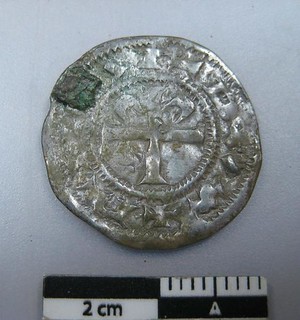 As a professor in numismatics, the study of currency, I have spent my life becoming an expert in coins, so was called to help them learn more about this exciting discovery. It turned out to be a very interesting find. Most of the coins were the types that we usually see in Sweden: English, Bavarian, Bohemian (Czech) and Islamic coins as well as imitations of Islamic coins. But one of the coins was unusual.
As a professor in numismatics, the study of currency, I have spent my life becoming an expert in coins, so was called to help them learn more about this exciting discovery. It turned out to be a very interesting find. Most of the coins were the types that we usually see in Sweden: English, Bavarian, Bohemian (Czech) and Islamic coins as well as imitations of Islamic coins. But one of the coins was unusual.
Found within this hoard was a Norman coin from the late tenth century. It is only the second Norman coin found in Sweden, and they have rarely been found in the rest of Scandinavia. This is surprising because the duchy of Normandy was created when King Charles the Simple of West Francia (roughly modern-day France) gave a bit of land to the Viking chief Rolf (or Rollo) in 911.
It turned out to be of a type that had not been seen since the 18th century. Several scholars had doubted the very existence of this type of coin, arguing that the 18th-century record was a misreading. But the Viggbyholm find proved that they were wrong. The type did exist. So this Swedish find contributes to our knowledge of French history.
At the moment, I’m working in close collaboration with the Archaeologists to interpret the hoard. The coin shows that it should be dated to the last years of the tenth century. All the coins were turned into jewellery, mounted as pendants. The hoard was very carefully deposited within a house. This shows that the Viggbyholm hoard belongs to a category of hoards deposited for special reasons, maybe a ritual of a kind that we do not know the exacts details of.
To read the complete article, see:
Swedish Viking hoard: how the discovery of single Norman coin expands our knowledge of French history
(https://www.newsbreak.com/news/2180825323012/swedish-viking-hoard-how-the-discovery-of-single-norman-coin-expands-our-knowledge-of-french-history)
THE BOOK BAZARRE
THE MARKSTETTEN COIN HOARD
Künker published an article about the Markstetten Coin Hoard discovered in 2017. Here's an excerpt. The firm is offering coins from the hoard in their auction 349. -Editor
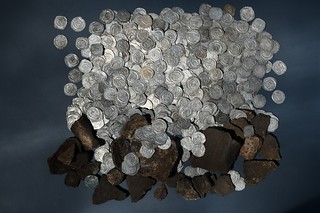 On 18 June 2017, a coin hoard was discovered near Markstetten: at one point after 1228, an unknown person buried a clay vessel, which contained exactly 560 pfennigs. Except for one piece, all pfennigs were minted in Regensburg. At the beginning of the 13th century, the town was not yet the free imperial city as we mainly recall it today, but a powerful bishopric, and several parties tried to control it, including the noble members of the cathedral chapter, rich citizens and the Bavarian duke.
On 18 June 2017, a coin hoard was discovered near Markstetten: at one point after 1228, an unknown person buried a clay vessel, which contained exactly 560 pfennigs. Except for one piece, all pfennigs were minted in Regensburg. At the beginning of the 13th century, the town was not yet the free imperial city as we mainly recall it today, but a powerful bishopric, and several parties tried to control it, including the noble members of the cathedral chapter, rich citizens and the Bavarian duke.
The major part of the Markstetten Coin Hoard consists of two coin types: type Emmerig 206
with 255 specimens, and type Emmerig 207
with 292 specimens. Until now, both of them could not be dated more specifically than around 1225
, an indication that had been laid out by Hubert Emmerig in his work Der Regensburger Pfennig
published in 1993. Eugen Voronin, who examined the Markstetten Coin Hoard from a numismatic and historical perspective, was able to date the coin types even more precisely. In order to understand his reasoning, we have to recall the political situation in Regensburg.
It would be wrong to assume that there was only one ruler of Regensburg in the late Middle Ages. Quite the opposite: many parties tried to assert their influence in the city. First, there was the cathedral chapter, which consisted of later born sons of noblemen who tried to promote the interests of their families. The cathedral chapter elected the bishop, and the decisive element was not the priestly vocation of the candidate but the power constellation regarding everyday life politics. Which noble family managed to convince enough canons to support them in order to make their candidate succeed?
The Legal Background
We wouldn’t know any of this if Eugen Voronin, an employee of Künker am Dom, had not scholarly analyzed the hoard. The coin hoard and the coordinates were previously reported to the Bavarian State Coin Collection in Munich and to all responsible institutions, including the Bavarian State Office for Monument Protection, to be examined and scholarly recorded. None of the authorized institutions exercised their right of first refusal, so now that the find has been scholarly recorded and evaluated, it can be offered for sale to the public.
Hubert Ruß, Managing Director of Künker am Dom comments: It was not only a legal, but also a moral and historical obligation for us to inform the honest finder about the necessary steps and to accompany him through the entire process. In Bavaria, the so-called ‘Hadrian’s Division’ has been applied since centuries. This law goes back to a roman emperor of the middle of the 2nd century AD. It states that the discoverer and the landowner share the hoard, and both are obliged to report it. In addition, the Bavarian state demands that every hoard be scholarly documented for posterity and, if it is a find of special importance, to purchase it. This was not the case with the Markstetten Coin Hoard. However, we decided to offer the find only after it has been scholarly reviewed, and to offer it as one lot hoping that a private or public buyer will preserve it as an ensemble for posterity.
To read the complete article, see:
The Markstetten Coin Hoard: Witness to a Political Thriller in the High Middle Ages
(https://www.kuenker.de/en/information/presseinformationen/aktuelle-mitteilungen/353)
1879 $4 COILED HAIR STELLA IN ALUMINUM
This Heritage press release highlights a rare pattern made of a once-but-no-longer precious metal. -Editor
Today’s Ho-Hum Metal Was Yesterday's Precious Object
The gold Coiled Hair Stella is a famous rarity, with those from 1879 having only about 12 to 14 pieces known today. Heritage will be offering a fascinating rarity that is actually even harder to find than the already-difficult gold version: an 1879 Coiled Hair Stella pattern coin struck in aluminum, Judd 1640! This fabulous piece from the Bob Simpson Collection is rare in its own right as a pattern coin and also has the advantage of being associated with the famously short-lived Stella pattern series, which was struck for only 2 years in 1879 and 1880.
Not only the design, but also the metal this coin was struck in, was a short-lived experiment for the US Mint as well. They tried out using aluminum for a few different pattern designs but never used this metal for regular-issue coinage--it was too soft and not reliable enough for the needs of commerce. Aluminum is so ubiquitous today that it may not strike you today as a metal that would belong on the "precious metals" list or that even has much value. However, in the early and mid-1800s, it was considered in the United States and Europe to be very precious indeed. This led to the production of some rare pattern coins (trial pieces made to test out new designs or metal compositions) struck in aluminum. In fact, for a time during the 1800s, aluminum was more valuable than gold!
As an example, the most honored guests of French ruler Napoleon III dined with aluminum cutlery, while the less-important were only able to use the more everyday silver forks and knives. The issue was not necessarily scarcity but rather than most people did not understand how to scientifically make use of aluminum. It was not until scientists found easy ways to release this metal from its ore (starting in 1886) that it fell from its favored position as an uncommon element to become something very pedestrian. Before that point eventually came, just a few very special aluminum pattern coins were created that have occasionally survived to be enjoyed by collectors today.
In addition to the great story behind it, this is an attractive coin that really stands out. It even has cameo contrast that lends a striking look to the frosty devices compared to the mirrored fields. Check out this intriguing piece here, where it is expected to sell for 6 figures:
https://coins.ha.com/itm/patterns/1879-4-coiled-hair-four-dollar-judd-1640-pollock-1840-high-r7-pr63-cameo-pcgs-pcgs-537346-/p/1329-11370.s
REBECCA LUKENS’S IRON MILL
Crystal M. Moten is curator of African American history in the Division of Work and History at the Smithsonian Museum of American History. In the museum's O Say Can You See? blog for March 9, 2021, she illustrates an obsolete banknote from the National Numismatic Collection with a connection to Women's History in American business. Here's an excerpt. -Editor
The inside of Rebecca Lukens’s mill is featured on this $10 Bank of Chester Valley note
A sudden tragedy thrust Rebecca Lukens into the family business and into history, making her the nation’s first woman industrialist and the only woman to run and eventually own an iron mill in the United States during the 1800s.
In 1825, at the age of 31 and expecting her sixth child, Rebecca Lukens endured a heart-wrenching loss. Her husband, Charles Lukens, died unexpectedly from illness. On his death bed Charles made Rebecca promise she would take over Brandywine Iron Works and Nail Factory, the family business which he had been running prior to his untimely death. Rebecca’s father, Isaac Pennock, was the original owner of the mill. He had died in 1824, and while he did not leave the business to Rebecca and Charles directly, he had made Rebecca a verbal promise that it belonged to her.
Rebecca had learned the business, first from her father, and then from her husband, who consulted her as he advanced and expanded the company. Though it was nearly bankrupt at the time of Charles’ death, Rebecca revived the mill and made it profitable, but this came at tremendous personal and financial cost.
Brandywine Iron Works specialized in the production of small iron products such as nails, wheels, barrel hoops, and blacksmith rods.
By 1818, the mill had become the first to roll iron boilerplate. In March of 1825, a foundry and machine shop in Pennsylvania commissioned Brandywine Iron Works to provide the material for the nation’s first ironclad steamship, the Codorus. Charles accepted the order, but he died in the summer before the completion of the ship. In November of that year, as the Codorus set sail on the nearby Susquehanna River, Rebecca took over the management of Brandywine Iron Works.
By the 1840s, Rebecca’s mark on the mill was undeniable. She had completely renovated it and made it profitable. By 1844, she was worth $60,000 (about $1.7 million in 2020). Rebecca died on December 10, 1854, but the company continued and remained in the family until Bethlehem Steel bought it in 1998.
To read the complete article, see:
Rebecca Lukens: A woman of iron
(https://americanhistory.si.edu/blog/rebecca-lukens)
INDIAN BANKNOTE EXHIBIT
A new exhibit by the Numismatic Society of Calcutta showcases the banknotes of India. -Editor
The first banknotes of India would be cut in half and sent separately by post for security reasons. The recipient would paste them together and present them at the bank for encashment.
An exhibition on 200 years of Indian banknotes, from Bank of Bengal to the Reserve Bank of India (RBI), is under way at the RBI Museum in Council House Street, Dalhousie Square. Organised jointly by The Numismatic Society of Calcutta and the RBI, it showcases some of India’s earliest banknotes.
The notes have a corner cut off and a cancelled mark is stamped on each. These were sicca rupee notes, which were used more like hundis, and could be encashed at the bank that issued them against the number of siccas, or silver coins, that their denomination suggested. Once encashed, they were cancelled this way,
explained Ravi Shankar Sharma, general secretary of the society, who is one of the nine collectors whose collections make up the exhibition.
According to Mahesh Kalra, curator of the museum, the exhibition was on the evolution of the banking system in India. Many private banks went bust as they were not supported by the government. In the early 19th century, presidency banks came into being, starting with Bank of Calcutta in 1806, which was renamed Bank of Bengal in 1809 by an East India Company charter. They brought out India’s first government currency, starting with notes in 1812,
he said.
While the four earliest specimens on display are unifaced, the next lot has Commerce, the figure of a lady sitting on a chest of money. Even the Confederate states in America used this figure,
Kalra pointed out.
The first one-rupee notes, issued during George V in 1917, came in booklets of 35 and had perforations at a side where they were torn off.
Then there are notes issued during the eras of Victoria, Edward VII and George V and the early issues of the RBI from 1938 to 1947. These have portraits of King George VI from 1938, signed by the second RBI Governor, J.B. Taylor and the third governor, C.D. Deshmukh, the first Indian governor of the RBI.
Another interesting group of exhibits is the Persian Gulf rupee notes. These notes were used between 1959 and 1966 in the British protectorates of the Arabian peninsula surrounding the Persian Gulf. These areas today form the countries of Kuwait, Bahrain, Qatar, Oman, and the United Arab Emirates,
Sharma said.
To read the complete article, see:
An exhibition on 200 years of Indian banknotes
(https://www.telegraphindia.com/west-bengal/calcutta/an-exhibition-on-200-years-of-indian-banknotes/cid/1809386)
BITCOIN BANKNOTES
A new firm with some all-star talent is planning to create secure banknotes tied to bitcoin. -Editor
Former Director of the US Department of the Treasury’s Bureau of Engraving and Printing (BEP) Larry Felix and Bitcoin Foundation Founding Chairman Peter Vessenes today announced a new project to create Bitcoin-backed banknotes through their co-venture, Noteworthy.
As the CEO of Noteworthy, Mr. Felix will oversee the design, development, and launch of the banknotes. I am thrilled to lead this transformative project,
he said. A physical banknote provides a level of trust, familiarity, and accessibility that digital assets on their own have yet to achieve. I look forward to working with the Noteworthy team to create a beautifully designed, easy-to-use, counterfeit-resistant banknote of the highest quality.
Noteworthy’s physical cryptocurrency banknote marries the utility and security from the paper money, digital asset, and blockchain industries. Equipped with a secure cryptographic microprocessor, and utilizing all of the banknote industry’s highest security features, Noteworthy notes will look and feel like top-of-the-line currency while providing the highest grade of digital security directly embedded in each note. Users will be able to interact with the notes through Noteworthy’s mobile app, further bridging the gap between the physical and digital.
Noteworthy has enlisted Manuela Pfrunder, the designer of the ninth series Swiss Franc and 2016 winner of the IBNS Banknote of the Year, as Chief Design Officer and Edmund Moy, 38th Director of the US Mint as an advisor. With design at the forefront of the project, Noteworthy has additionally partnered with renowned banknote image engraver, Thomas Hipschen, to assist with the portrait components of the note. Hispschen, who has engraved over 130 U.S. postage and revenue stamps as well as the portraits of Benjamin Franklin, Ulysses S. Grant, Andrew S. Jackson, and Abraham Lincoln on the current $100, $50, $20, and $5 US banknotes, has come out of retirement to join Noteworthy.
I think of this project as ‘Bitcoin has hired the world’s best banknote team,’
said Peter Vessenes. When I started working in Bitcoin, 1 BTC was worth less than $0.0005. Today we’re discussing a $50,000 banknote. That’s an incredible thing and I’m super excited that Larry, Manuela, and Thomas are bringing it to life!
In addition to Felix and Hipschen from the BEP, the firm's advisors include Douglas Crane of banknote paper maker Crane & Co., and former U.S. Mint Director Ed Moy. -Editor
To read the complete article, see:
Banknote Expert Larry Felix and Cryptocurrency Pioneer Peter Vessenes Partner to Create Bitcoin Banknotes
(https://www.northwestgeorgianews.com/associated_press/business/banknote-expert-larry-felix-and-cryptocurrency-pioneer-peter-vessenes-partner-to-create-bitcoin-banknotes/article_b3f3c13f-e425-5389-bf5a-2349ab969879.html)
LOOSE CHANGE: MARCH 14, 2021
Here are some additional items in the media this week that may be of interest. -Editor
American Numismatic Society librarian David Hill published an article on the ANS Pocket Change blog about the U.S. government's sale of unused escape and evasion kits. -Editor
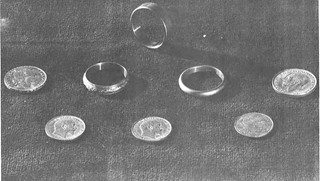 A researcher’s inquiry recently got me thinking about an interesting item I’d once found in a pile of unprocessed materials in the ANS Library. It was an auction catalog put out by a division of the U.S. Department of Defense to sell World War II escape & evasion kits, also called barter kits.
A researcher’s inquiry recently got me thinking about an interesting item I’d once found in a pile of unprocessed materials in the ANS Library. It was an auction catalog put out by a division of the U.S. Department of Defense to sell World War II escape & evasion kits, also called barter kits.
These kits, each containing a handful of gold objects, including coins, were, according to the catalog, issued to pilots and paratroopers to barter their way out of difficult situations if they were downed in unfriendly territory.
Reportedly, none were ever used for this purpose, so the kits were gathered and shipped off to the New York Assay Office, where they sat until 1979, when they were offered for sale in this auction.
Two kinds of kits were issued, one for the Atlantic region, containing gold rings, half- and one-pound gold sovereigns, and twenty- and ten-franc gold coins, and one for Southeast Asia, containing gold rings, a gold embossed pendant, a gold four-linked chain, and a 21-jewel Swiss calendar watch.
To read the complete article, see:
WORLD WAR II BARTER KITS
(http://numismatics.org/pocketchange/barter-kits/)
Louis Golino published a CoinWeek article March 11, 2021 on the Royal Mint's recent sellouts of new coins utilizing classical designs. -Editor
The February 22 launch and instant sell-out of The Royal Mint’s Three Graces silver and gold coins underscores the intense demand that exists for modern tributes to classic coin designs. The release of such coins needs to be handled very carefully with as level a playing field as possible since they often amount to the numismatic version of a winning lottery ticket with huge aftermarket potential much as did the November 5 launch of the V75 American Gold Eagle.
In November 2019, the Royal Mint launched a new series of silver and gold collector coins called The Great Engravers
, which pays homage to the most famous numismatic motifs in British numismatic history and the engravers who created them with tribute coins made using the original dies combined with 21st-century coin minting technologies.
To read the complete article, see:
The Coin Analyst: From Una and the Lion to the Three Graces – Classic Royal Mint Motifs
(https://coinweek.com/world-coins/the-coin-analyst-from-una-and-the-lion-to-the-three-graces-classic-royal-mint-motifs/)
Found on Quora. -Editor
During WW2, a Great Dane named Juliana was awarded the Blue Cross Medal in 1941 after she extinguished an incendiary bomb by peeing on it.
To read the complete article, see:
What is an interesting fact of history that most people don't know?
(https://www.quora.com/What-is-an-interesting-fact-of-history-that-most-people-dont-know)
See also:
Juliana (dog)
(https://en.wikipedia.org/wiki/Juliana_(dog))


